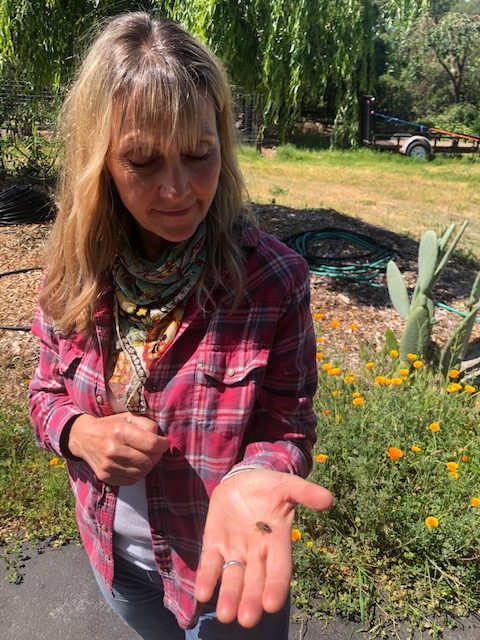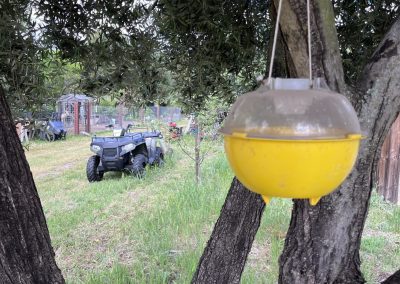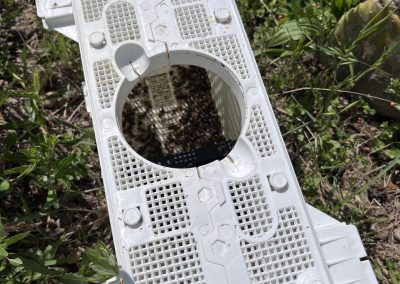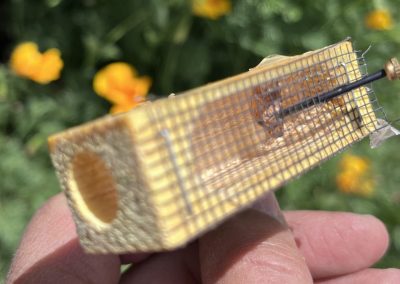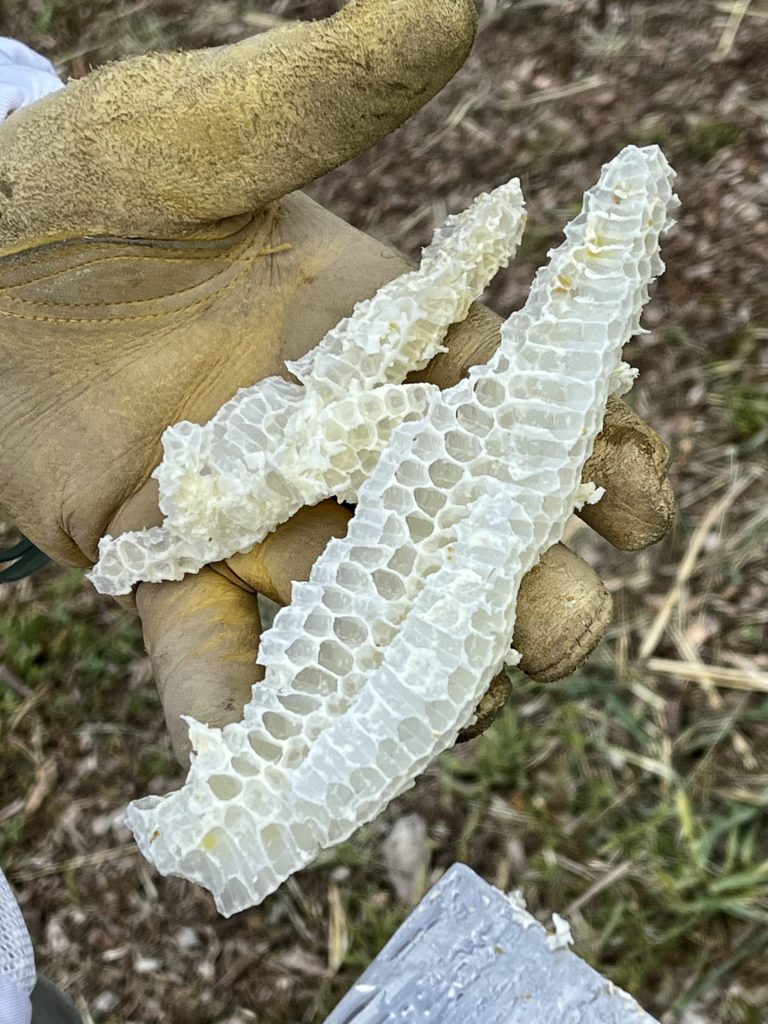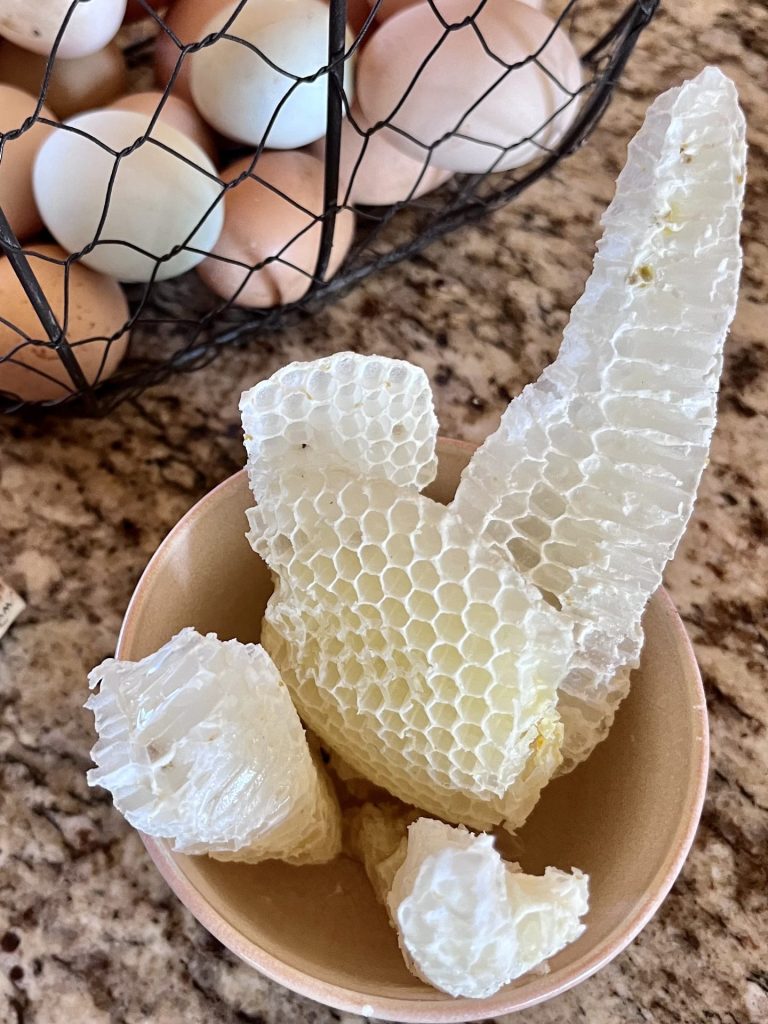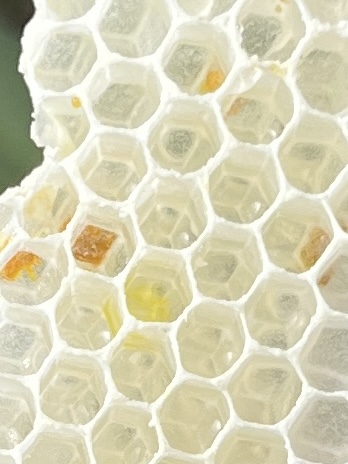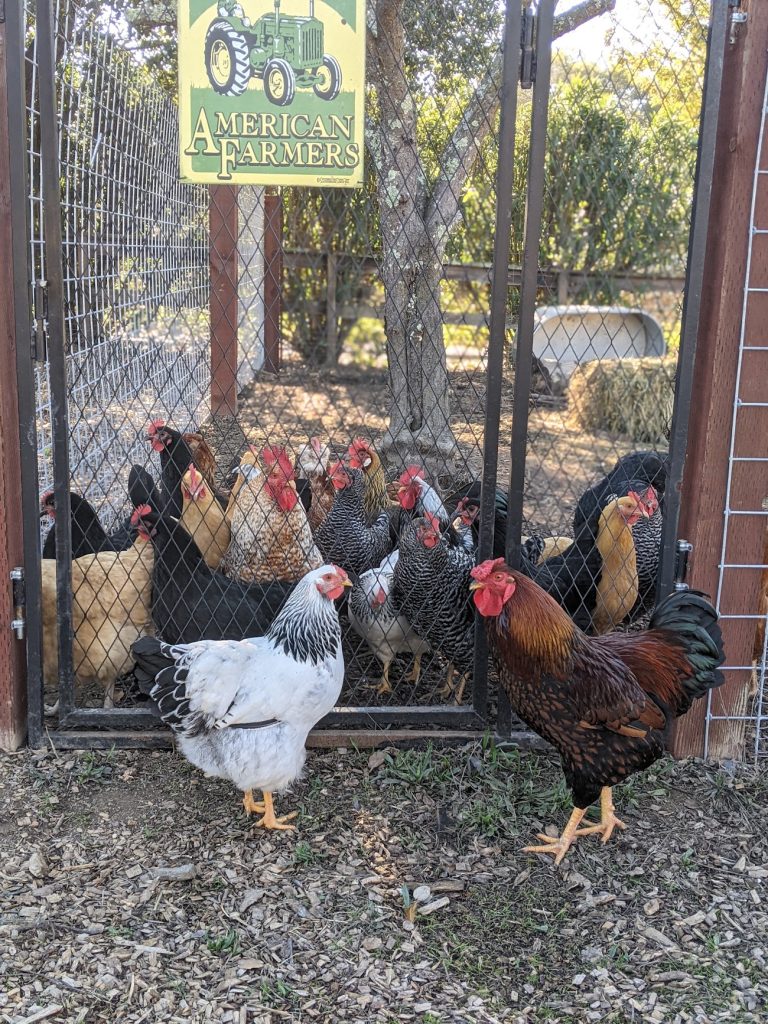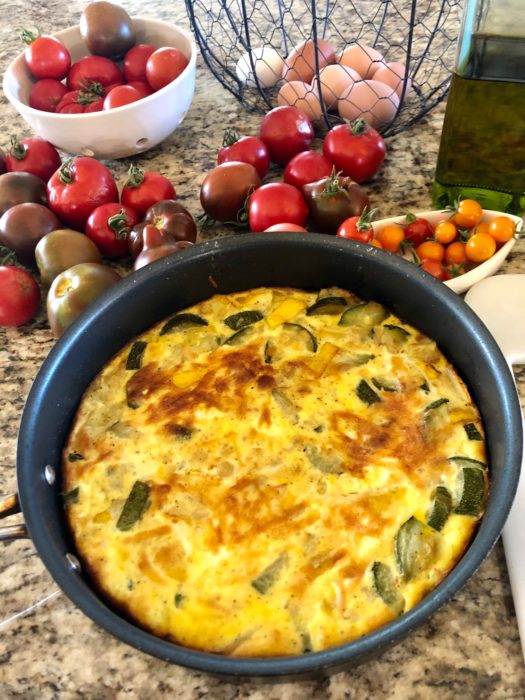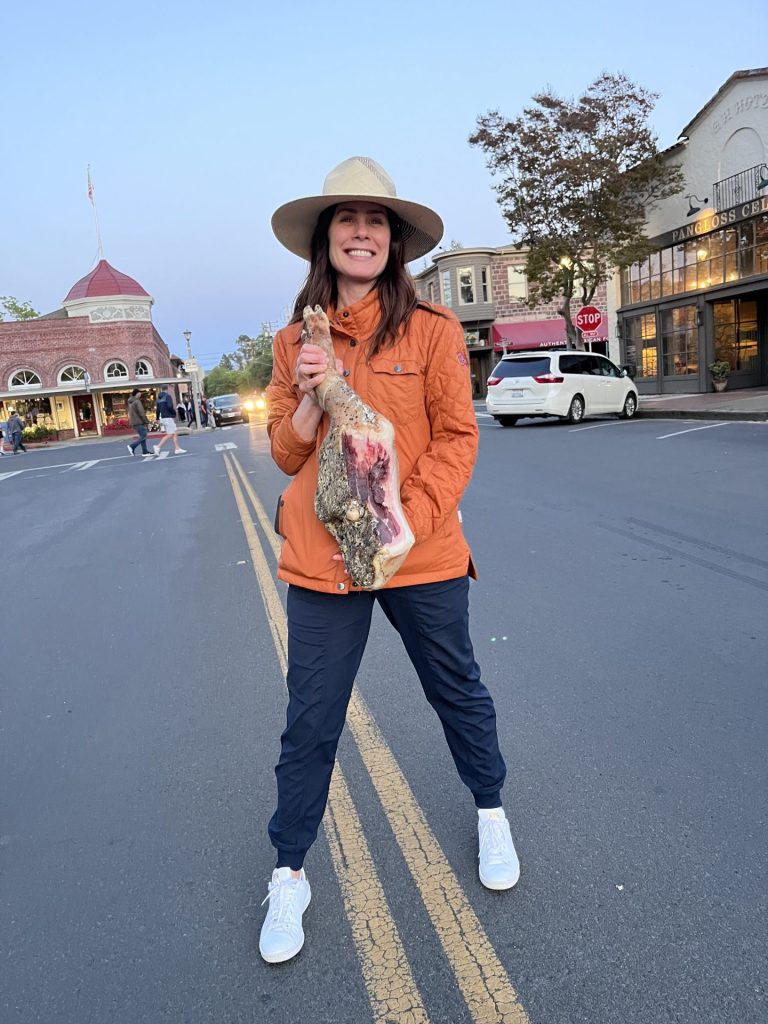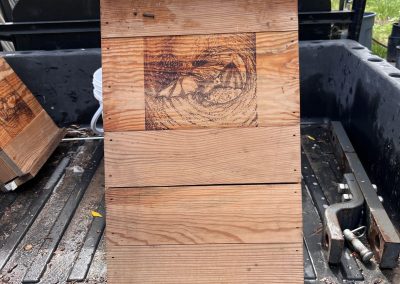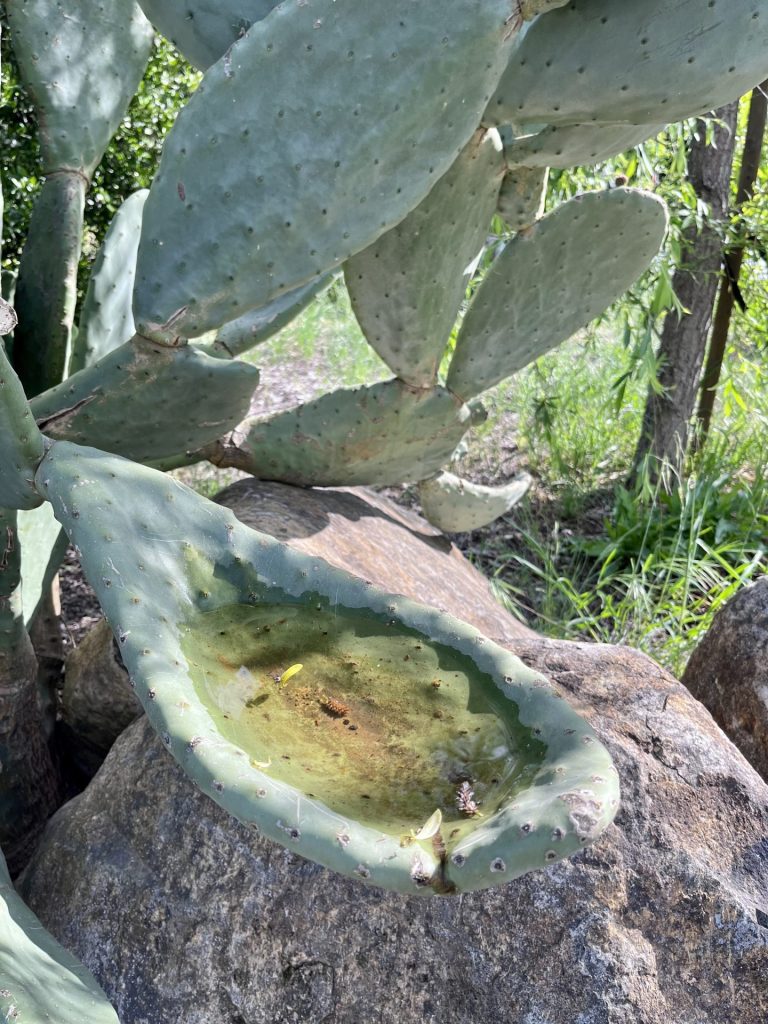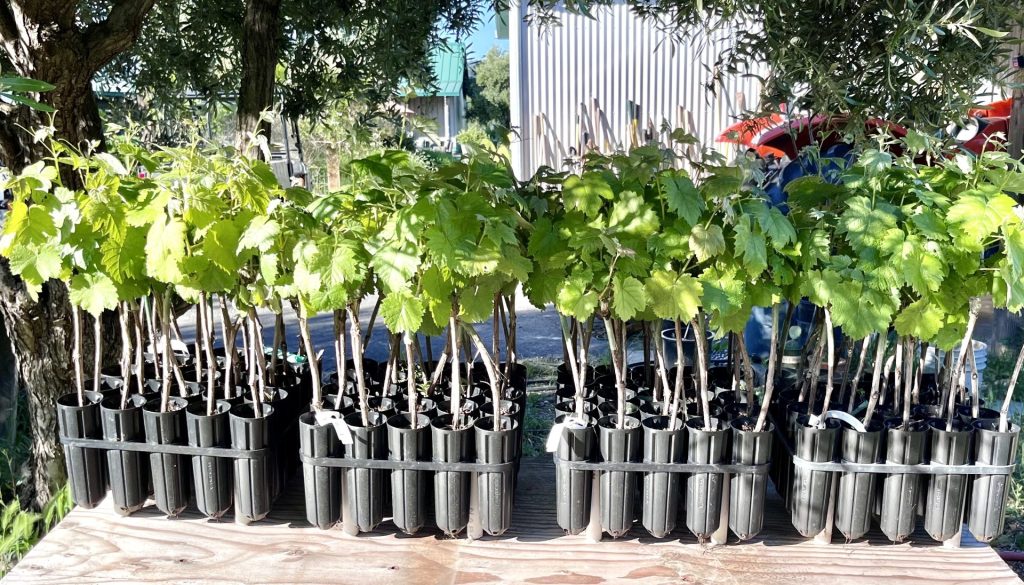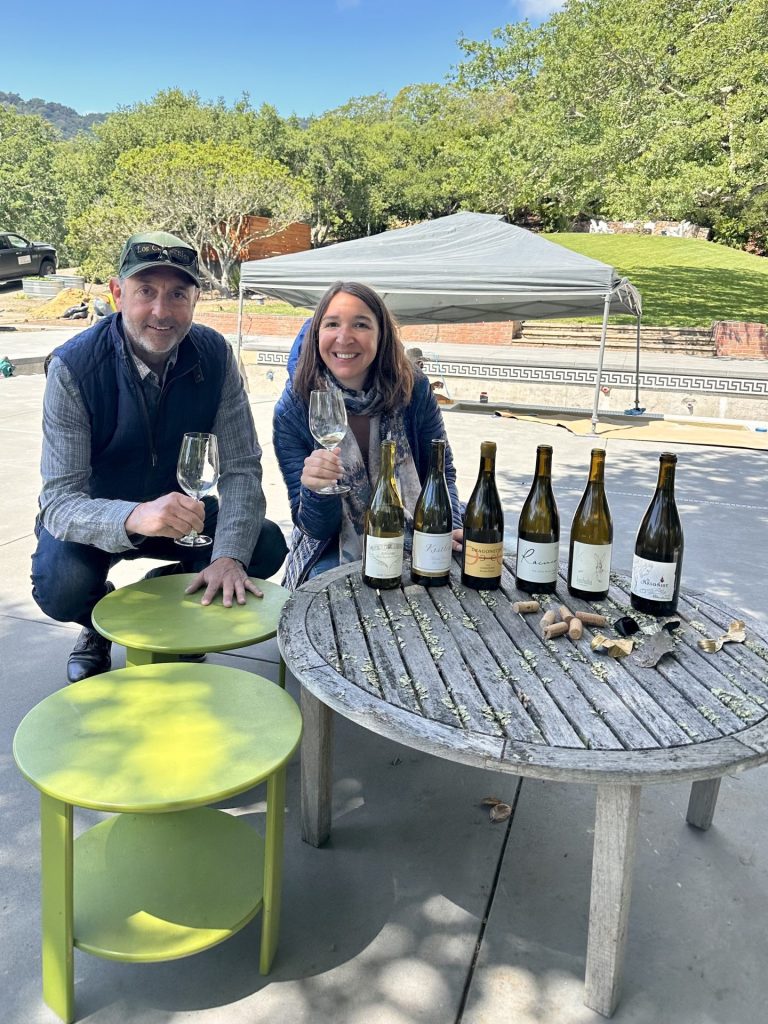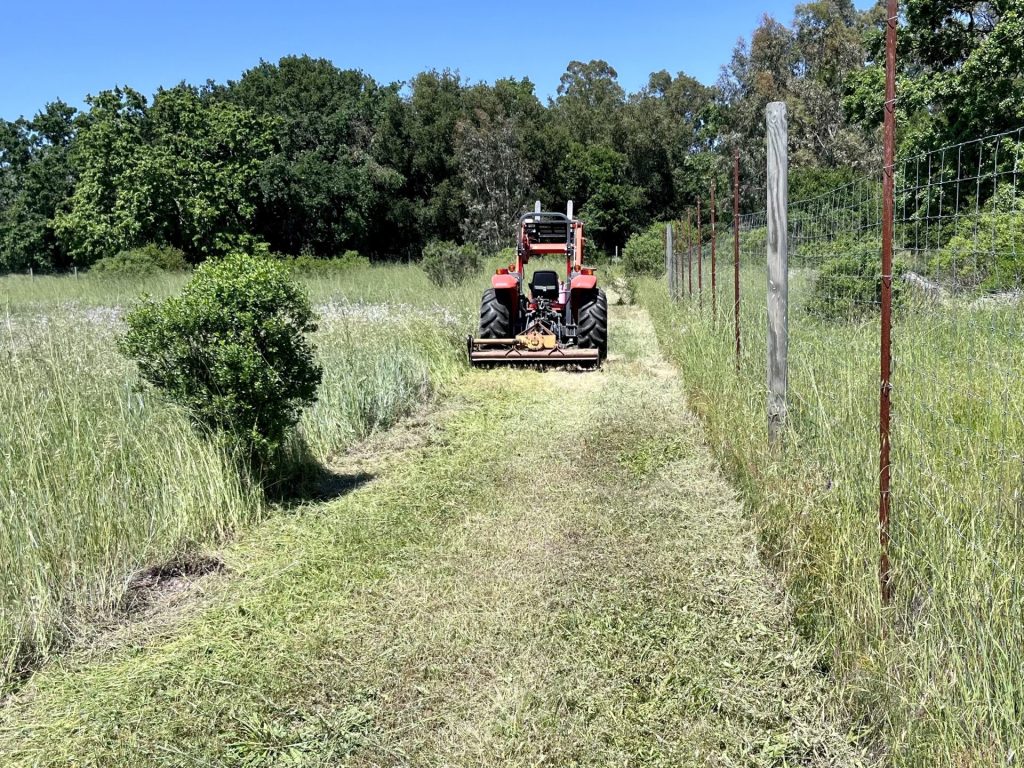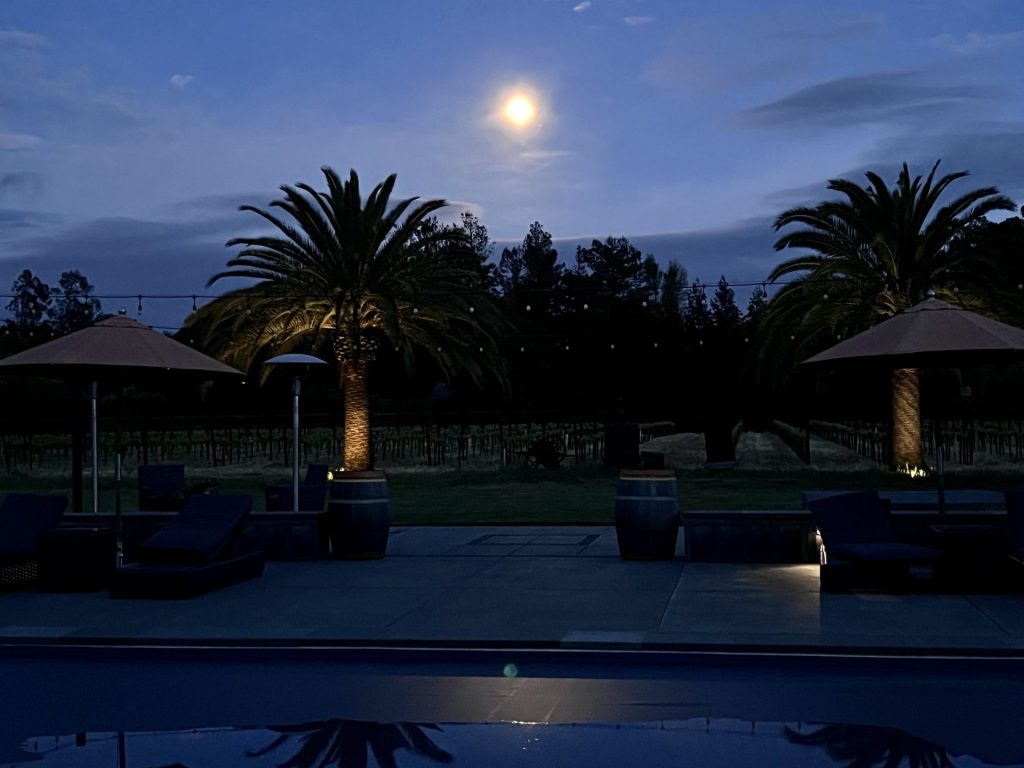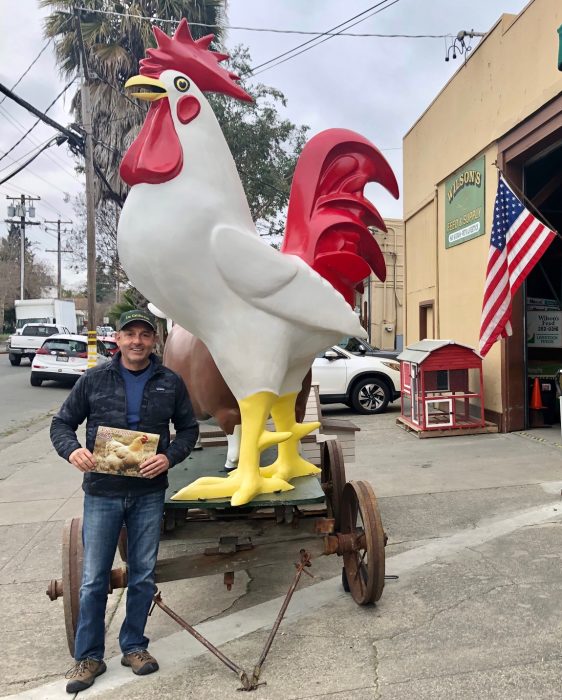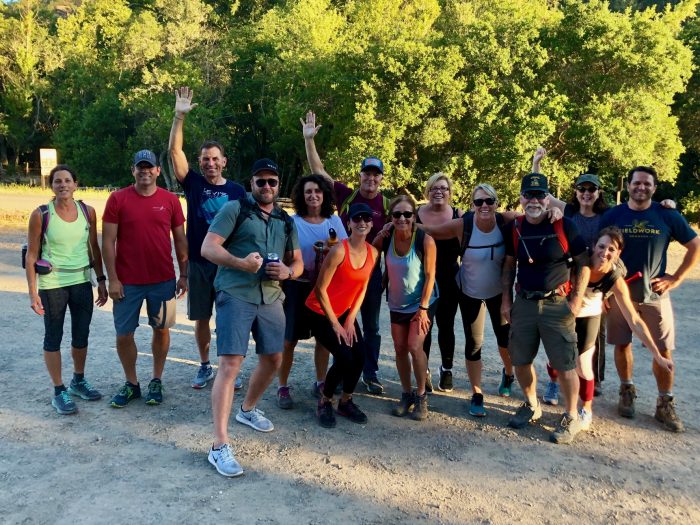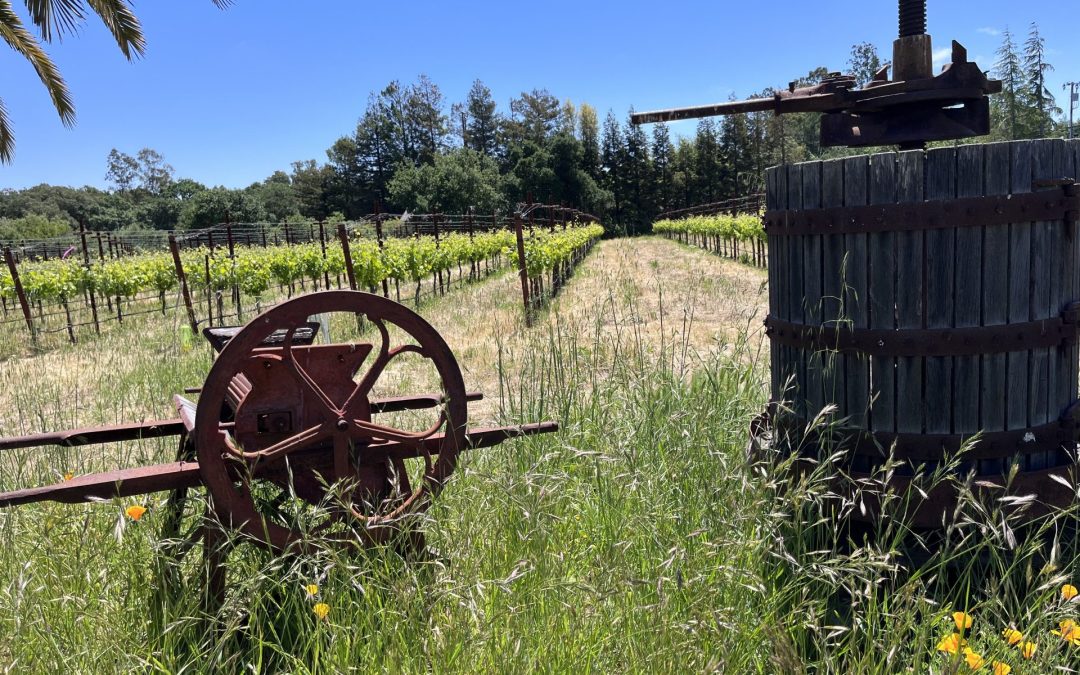
Jun 7, 2023 | Dysfunctional Family Winery, Hydeout Sonoma, Sagrantino, Sonoma, Sonoma Farming, Sonoma lifestyle, Sonoma Valley, Vineyard, Wine
Part 2 of farming and wine life in the Sonoma Valley…
Honey Bees and a National Park Ranger Talk on the Light Spectrum
Honey bees being a constant topic here at the Hydeout, what a great surprise to find a recent national park ranger talk on the color perception of bees! Turns out, honey bees see further out than humans on the light spectrum – which is why they can more easily find nectar in flowers. And why they don’t really like the color black.
Honey bees (cont’d)
Here are some more images of our work last week in the honey bees hives:
American Graffiti in Petaluma
This year marked the 50th year since George Lucas’ coming-of-age movie American Graffiti was released on the silver screen. Cruisin’ the Boulevard showcased hundreds of American model cars 1972 or older who joined in the annual parade of classic American cars cruising through the streets of downtown Petaluma where most of the movie was filmed in the summer of 1972. The best place to watch was along Petaluma Boulevard, south of B Street to D Street.
Fire
Sad to say we’ve had two fires already in our lovely Hyde-Burndale neighborhood. The first was a grass fire from some untimely afternoon high grass mowing. Our local neighbors with a water truck beat the firefighters to the scene (due to a faulty address) and had the fire out quickly.
The second, was a structure fire right across the street from us. The awesome and very local Schell-Vista Fire Dept arrived, followed closely by Cal-Fire, and that fire was also put out quickly. Hopefully the last of this fire business for the year.
Meal Fit for a King
Hosted by noted Napa vintner John Boich of Boich Cellars, we enjoyed an incredible food and wine event at their Wall Road vineyard (where we are farming Cabernet and Syrah for Boich). Check out the menu below for each of these incredible dishes:
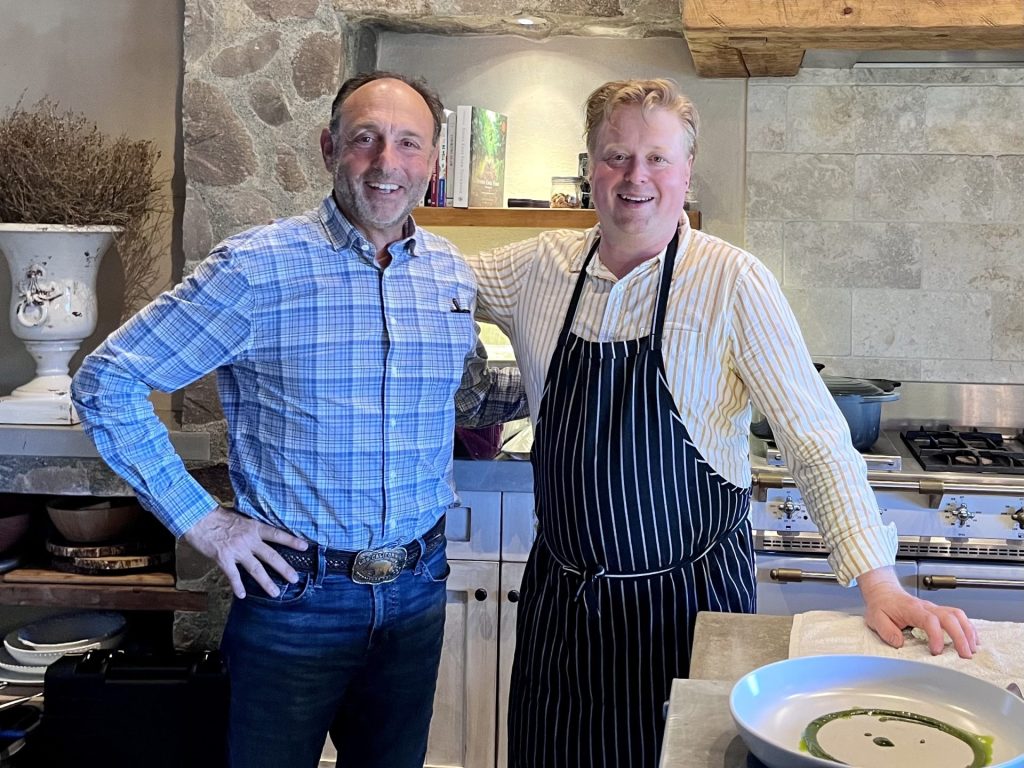
Yours truly, Ken Wornick, with chef extraordinaire Landon Schoenfeld of Oak and Acorn Luxury In-home Dining
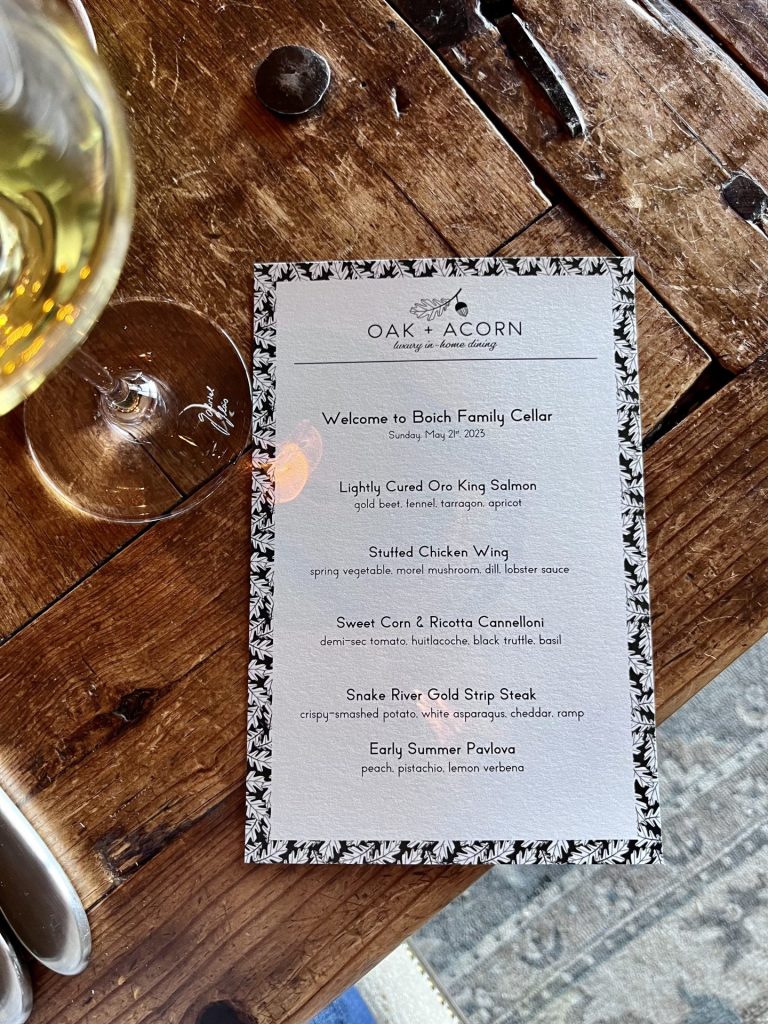
The Boich Cellars menu from Oak and Acorn Luxury In-Home Dining. Find them at 612-618-5909, oakandacorndining@gmail.com
Wildlife
After a very wet winter, wildlife activity is booming around Sonoma and at the Hydeout. These images, shot by professional photographer Michael Hodgson, Sony Pro photographer & travel journalist, at www.michaelhodgsonphoto.com and michael@hitraveltales.com
Snake!
This is first time ever finding a snake at the Hydeout. Snakes, especially rattle snakes are super common up in the hills around Sonoma. Down here in the almost-flats, we have very few to zero rattlers. This snake however is actually a common gopher snake that was leisurely crossing the driveway. I grabbed it, put it in a bucket, and took it straight out the vineyard where it very quickly disappeared down a gopher hole – to my very great delight!

Cork from Ganau, it’s Italian for cork
Our primary supplier of cork is Ganau, a local Sonoma company run by terrific people. In this video, you can see a natural product, cork, being naturally branded by fire. Click here to watch a 30-second video of cork being fire-branded at the Ganau plant

Fire branded and ink branded corks
Final thought…
Fun night at the Big Easy in Petaluma seeing Illegitimate AC/DC. Fronted by my buddies Bob Taylor (as Angus, center, guitar) and James Marshall Berry (right, on bass). They rocked hard all night long. Bob and James are also an integral part of KSVY Sonoma, our local radio station. I was a guest on Bob’s The Morning Show last week – check it out here: listen to Ken Wornick on the KSVY Morning Show

Next up – watch for a big announcement!
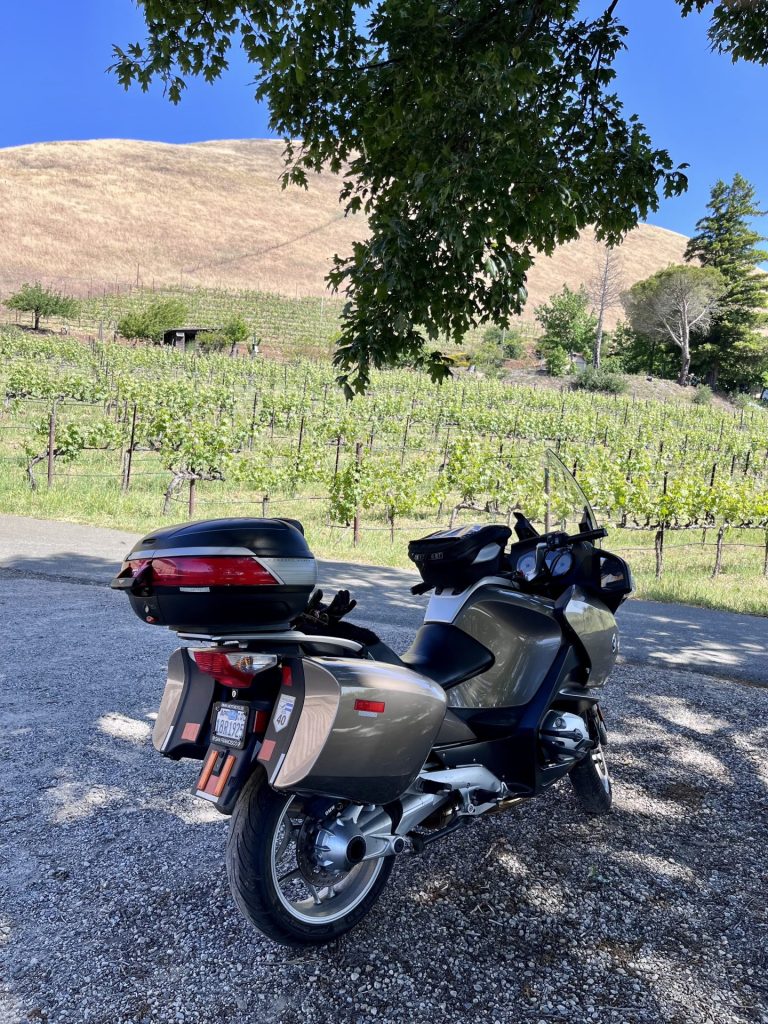
My trusty 2007 BMW R1200RT gets me around to all the vineyard sites we farm.
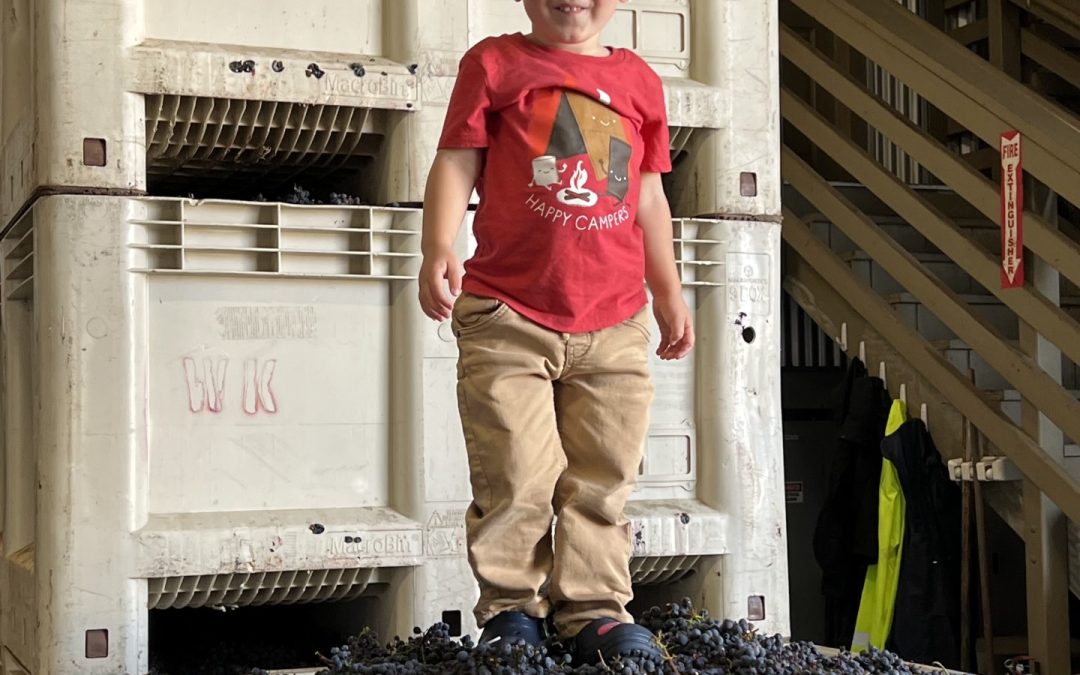
Oct 22, 2022 | Uncategorized, Hydeout Sonoma, Sonoma, Sonoma Farming, Vineyard
Passing the 1,000 blog readers mark, and with my thanks to you all, here are 50+ images from this, my 23rd vintage. – Ken Wornick
Blending trials for bottling aged reds prior to harvest
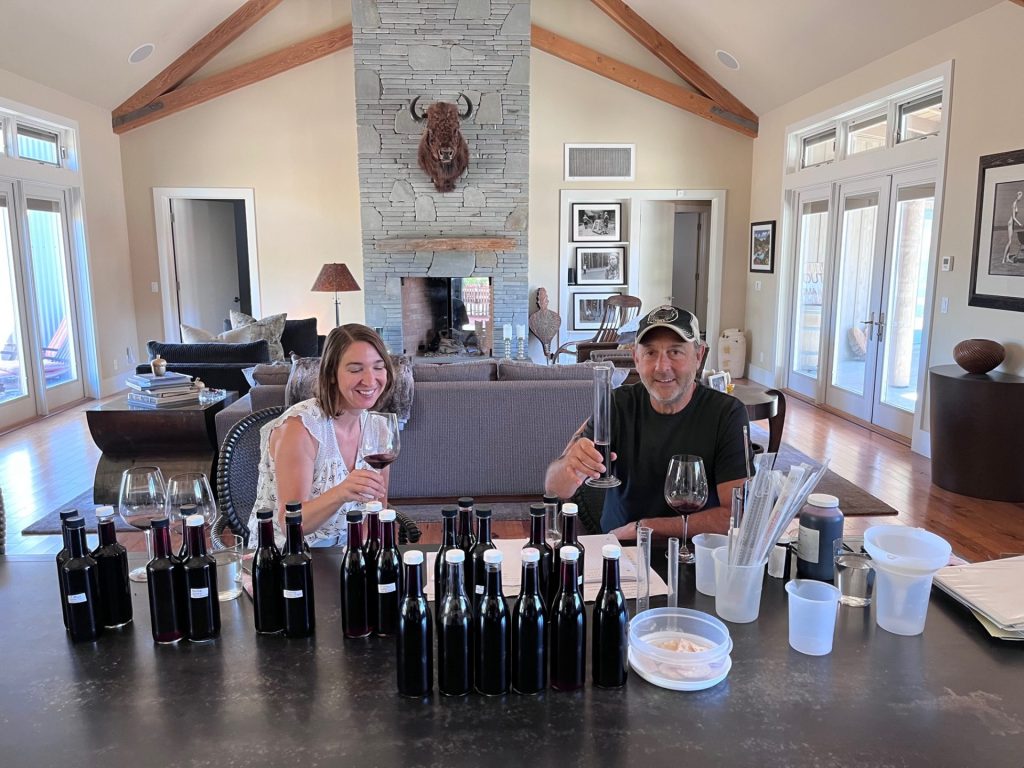
Faith and I needed to plan the bottling of the remaining 2020 client red wines that were still aging in barrels. To get ready, we conducted blending trials for some of our client wines here at the Hydeout Sonoma kitchen table.
Note the grouped samples as source wines, the pipettes and beakers, and so on. We start with the base wines, tasting notes, and lab chemistry in hand. Then we try to imagine what actions will give lift, depth, and longevity to each wine. Blending is a fun process because after spending a year growing the fruit and another year producing and yet another year aging the wines, it is really nice to sit in a warm quiet well-lit place and taste each wine one last time with focus and concentration. And then somehow with a bit of alchemy, create delicious artistry from all of the components.
Bottling
While the 2021 vintage continues to age in barrels, and the 2022 harvest approaches, emptying barrels of perfectly-aged and blended 2020 red wine for bottling also creates needed space in the winery for the incoming 2022 vintage.
One of the best days for what we do is delivering a completed bottled vintage to our clients, sometimes 26 months of waiting! Here are 3 recent examples:
4:00am start on an early morning in August, 2022
Harvest 2022 started for us in mid-August with some client hillside fruit on Arrowhead Mountain in southern Sonoma. What a moment it is every year when we shift from farming, which started way back in January, and finally seven to nine months later the fruit is ripe and we’re ready to harvest.
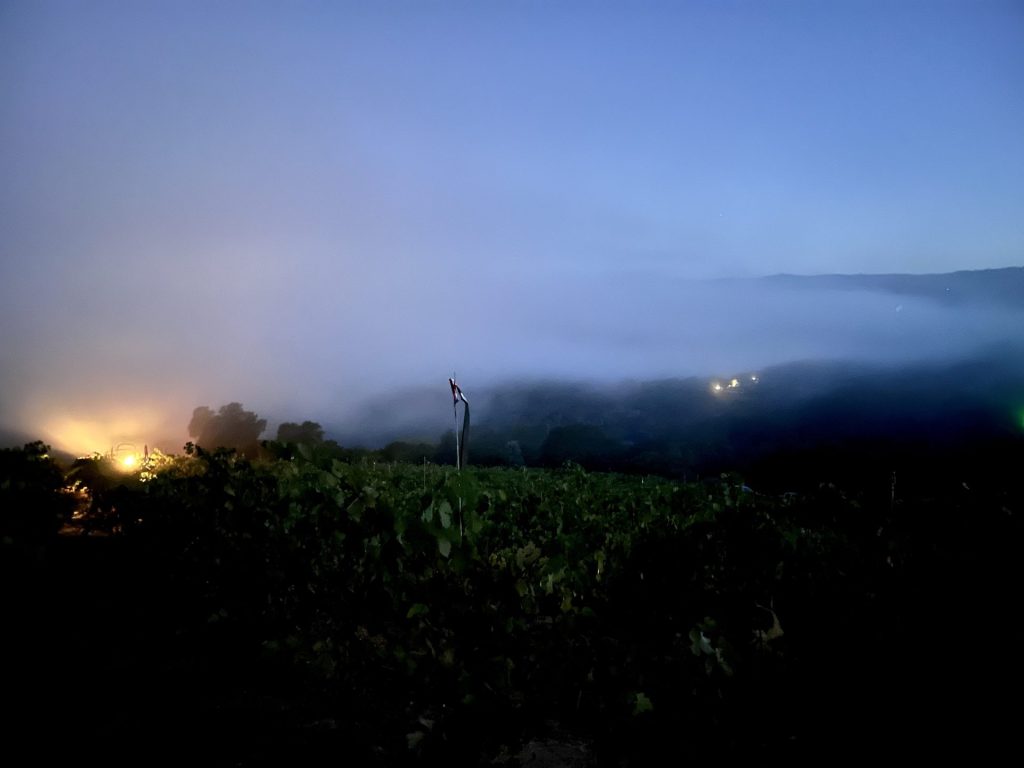
A cool dense layer of fog sits on the valley floor below this vineyard block, as the slowly approaching tractor lights glow in the background
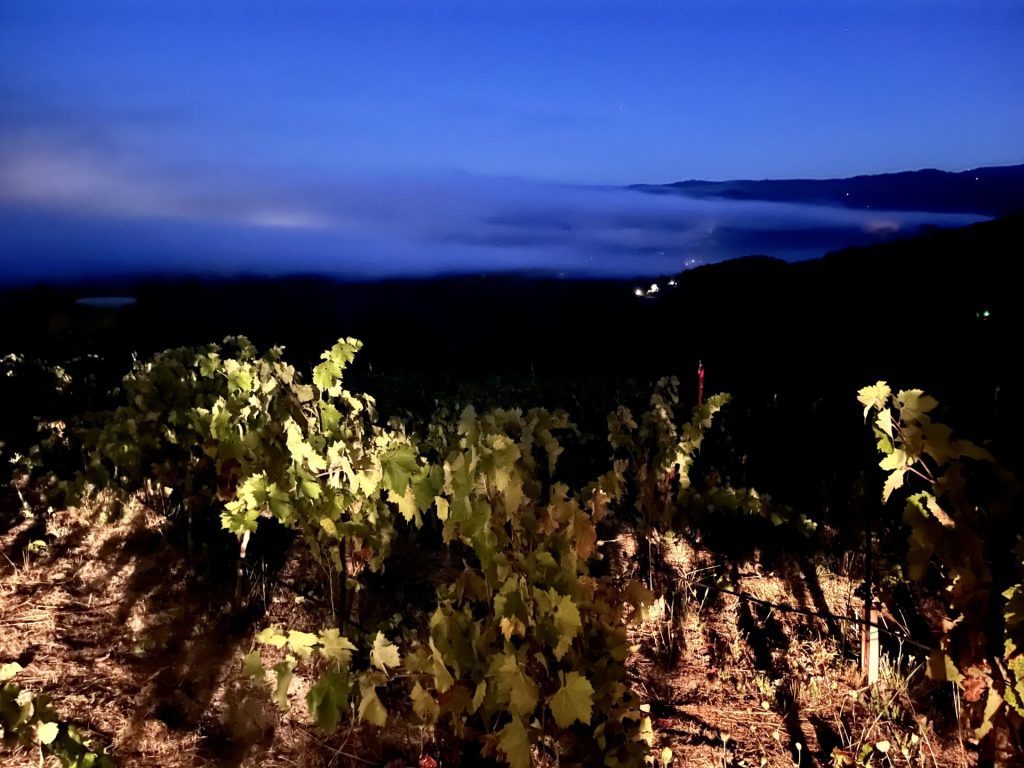
A slight breeze and the fog suddenly shifts as the sun almost rises (note the 3 house lights down below no longer in fog)
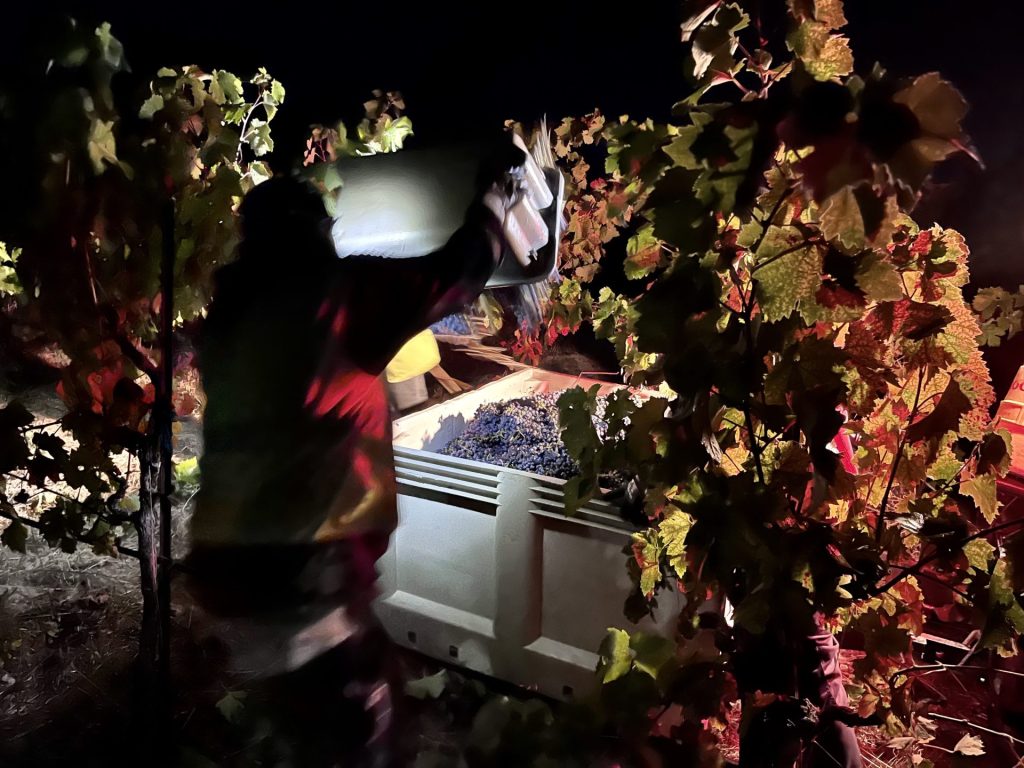
But it’s still dark inside this vine canopy as fruit fills the 1/2 ton bins of Zin
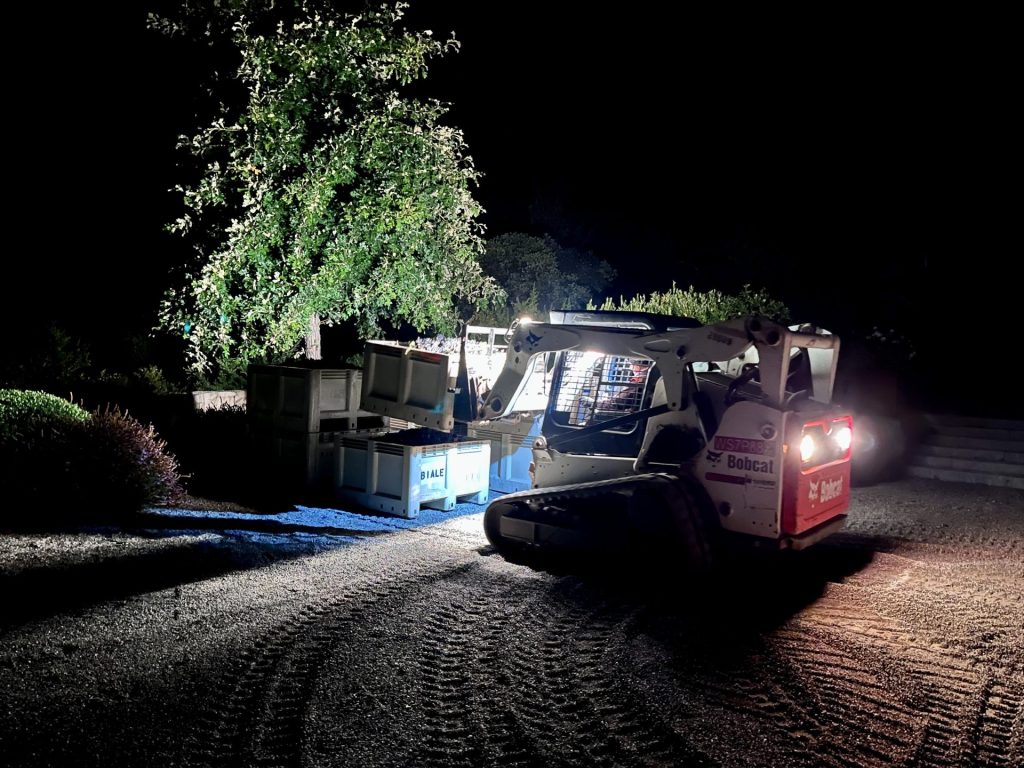
A bobcat grabs more empty bins and rushes them into the field
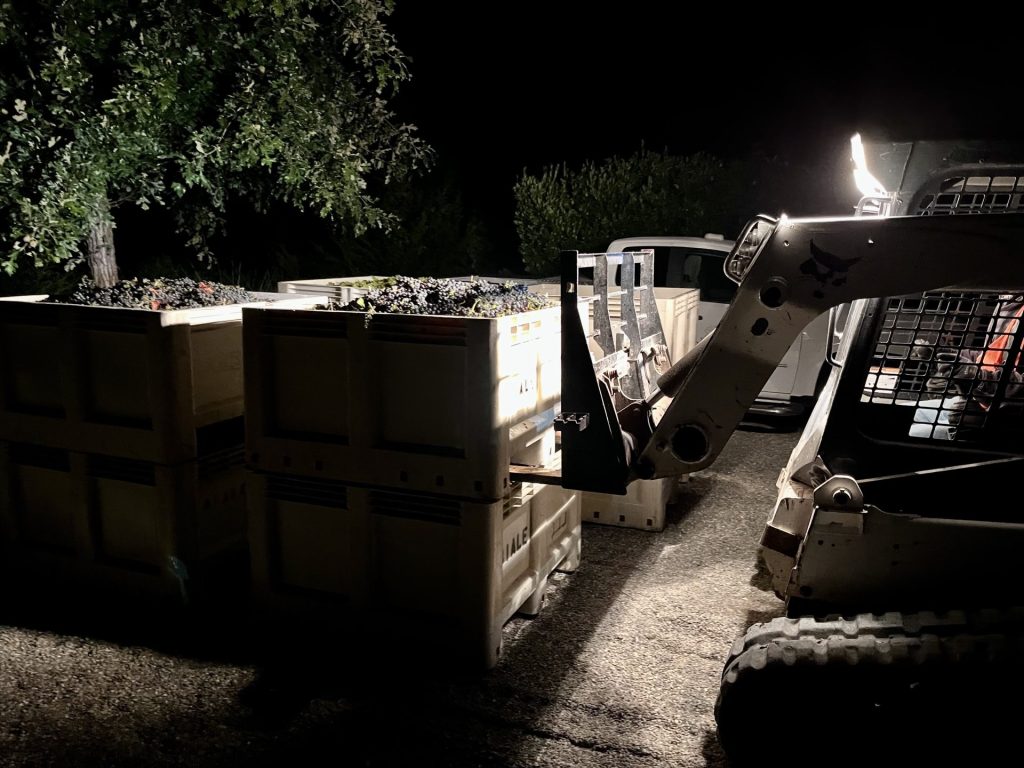
And minutes later returns with full bins of fruit. These bins are then rushed to the winery; we want that fruit to be ice-cold when it arrives.
Click here to watch a video of a night harvest
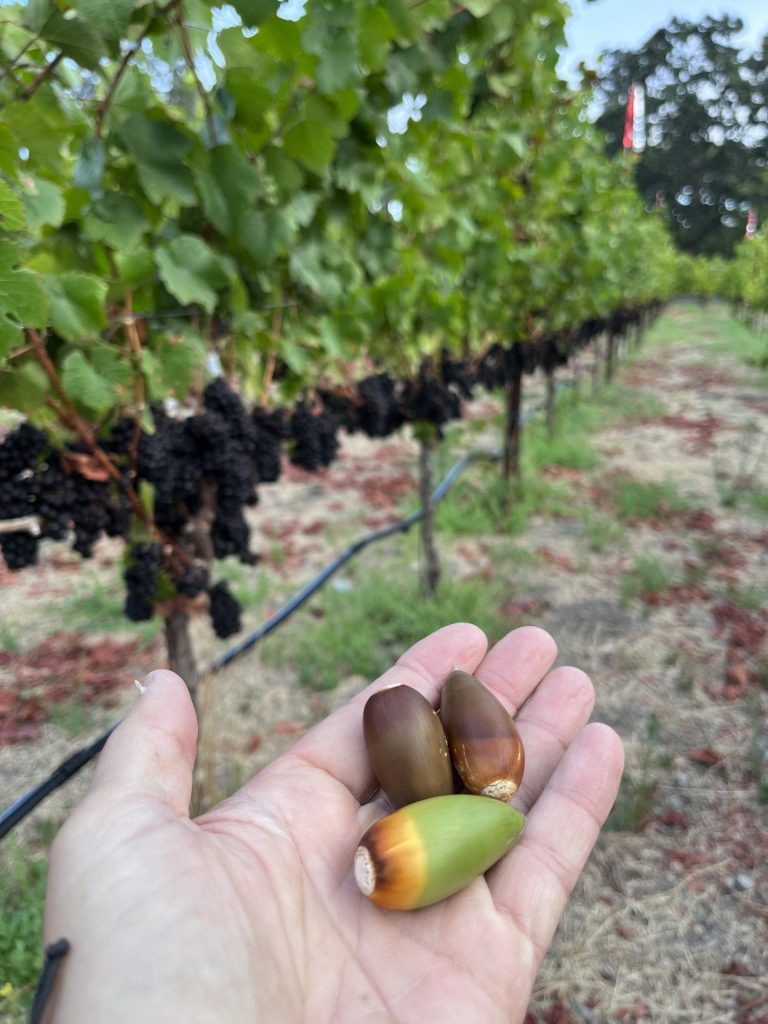
My next stop is to check out a client’s Eastside Sonoma Valley Pinot Noir vineyard scheduled to pick in the following few days. Note the dark tight-fisted bunches as is the nature of Pinot Noir.
I can never resist picking up oak acorns. Every year, I start another crop of oak seedlings from acorns, for planting around the Hydeout ranch. Some of the most impressive oak trees and their falling acorns surround vineyards in Sonoma. And those majestic beauties produce some amazing acorns that one day will themselves be majestic oak trees.
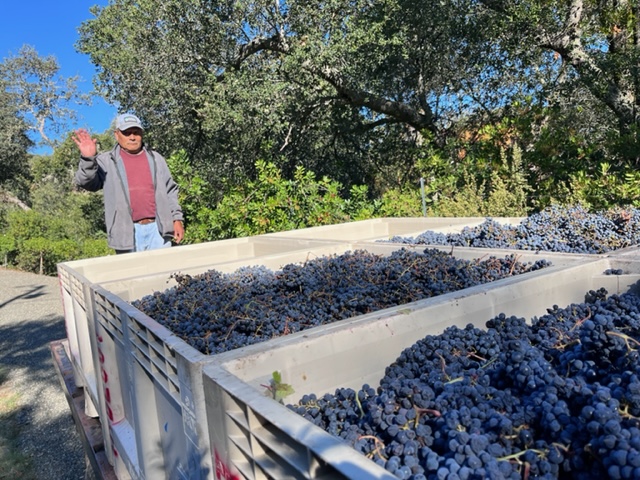
Another harvest a few days later. Ready to drive a load of Sonoma Mountain Cabernet Sauvignon to the winery.
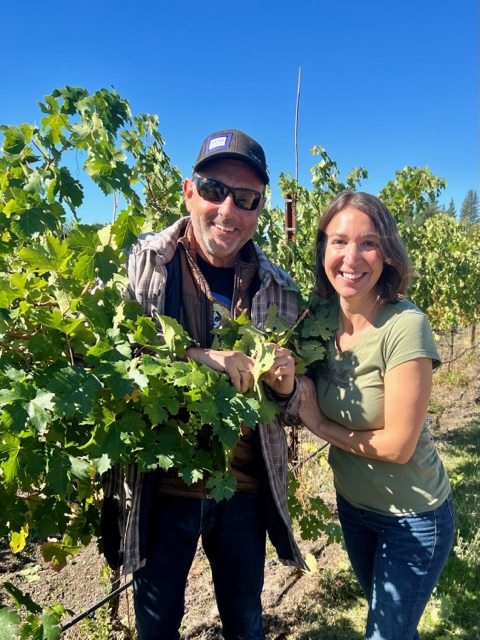
We start in the early morning hours and we look up and suddenly we realize the sun is out and it’s warm outside. Here, a moment of pause to celebrate the process of harvested grapes with Hydeout Sonoma partner and winemaker Faith Armstrong.
Processing fruit in the winery
Growing and harvesting great fruit is only half the battle. Next up is the winemaking. Every load of fruit is very carefully weighed, by law, so that each client’s property can be carefully tracked all the way into bottle; every single drop.
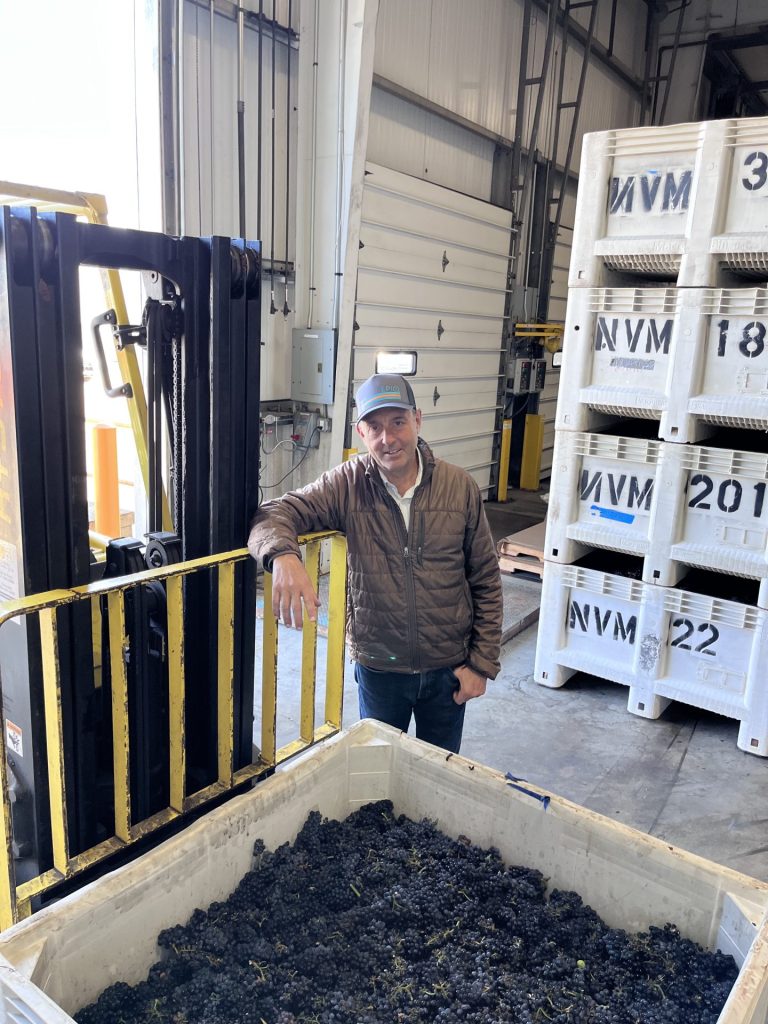
The first few bins of Pinot Noir from another early morning harvest go onto the scale
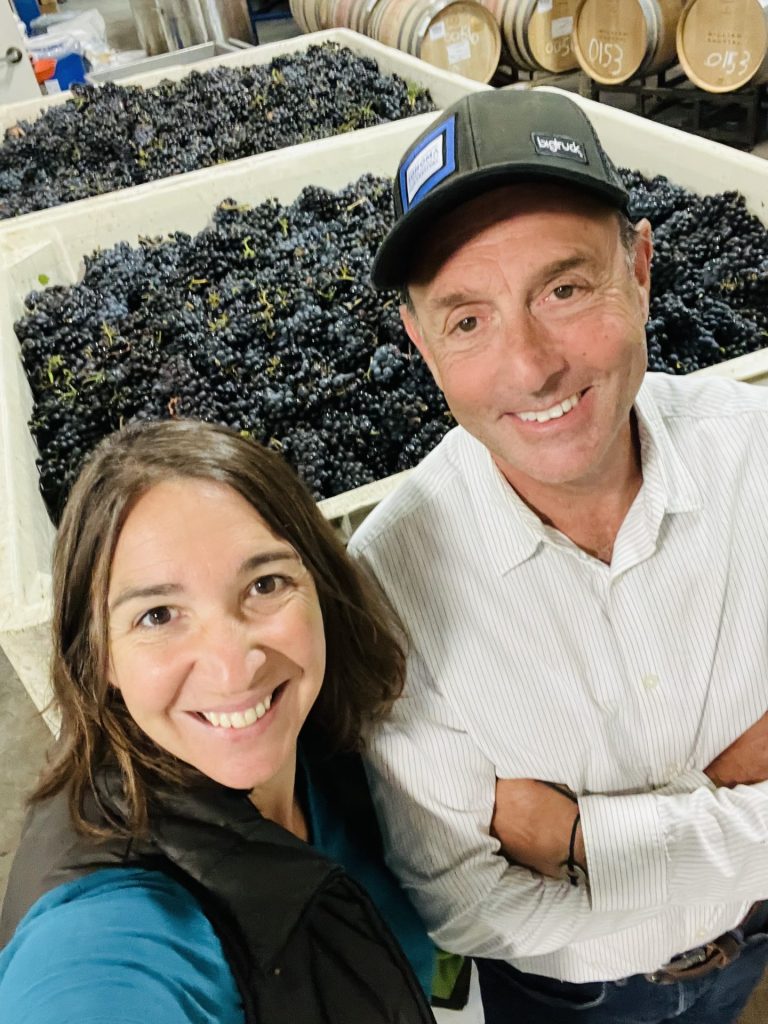
Moving into September, the long slow harvest continues to roll along as tank after tank fills with fermenting fruit. Here, happy winemakers about to get started on some pristine Zinfandel
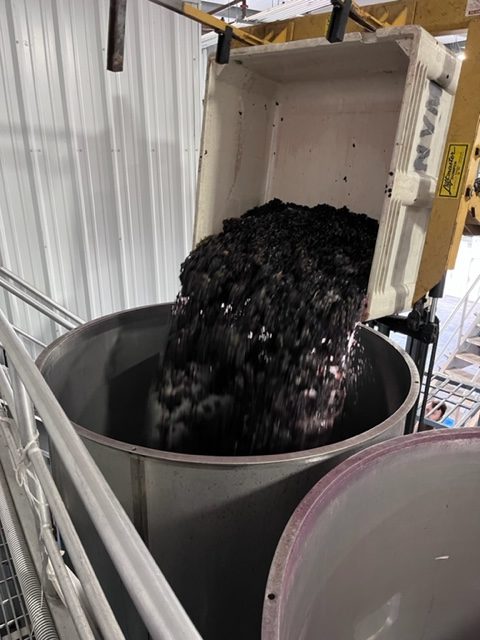
In early October, processing some Syrah from Kenwood into a 7-ton tank. The fruit from this vineyard is just across the street from Landmark Winery in Kenwood.
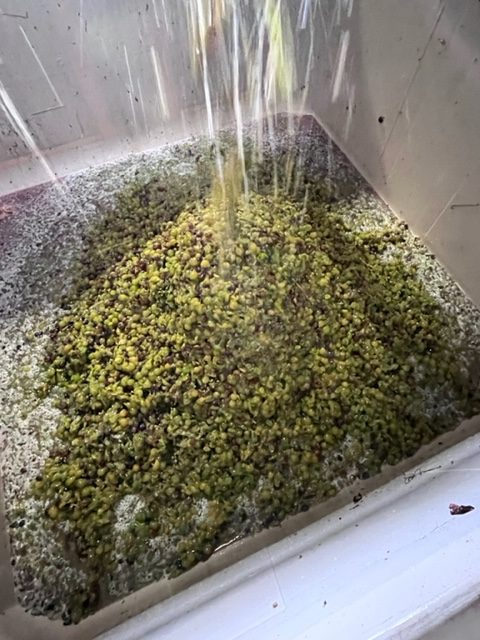
Muscat Canelli is not a very well known wine, but we love it. There are so many beautiful and under-appreciated grape varieties across the globe. This Muscat, from the Carneros Appellation in the Hyde-Burndale neighborhood, is packed full of tropical fruit and incredible peach aromatics.
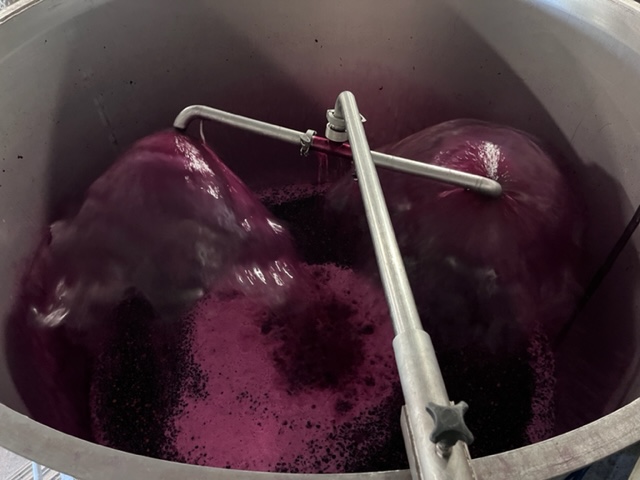
Irrigating a tank a of Grenache, a process where the fermenting juice is pumped from the bottom of the tank and “irrigated” (and oxygenated) over the top of the “cap” (the fruit floating to the top and pushed there by the expanding CO2 gas), thus encouraging the yeast to thrive and to keep the cap wet (because if it dries out, bad things can happen like the formation of vinegar).
Click here to watch a quick video of “irrigating” the cap
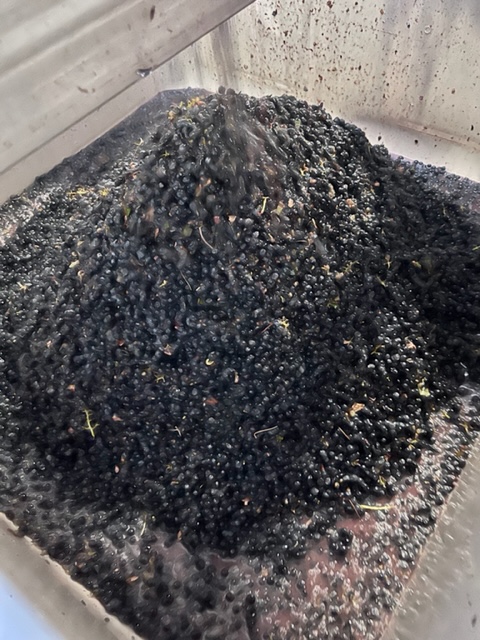
Now mid-October, and we’re still at it. Here, clean de-stemmed fruit accumulating in a bin, headed to a fermentation tank in a moment
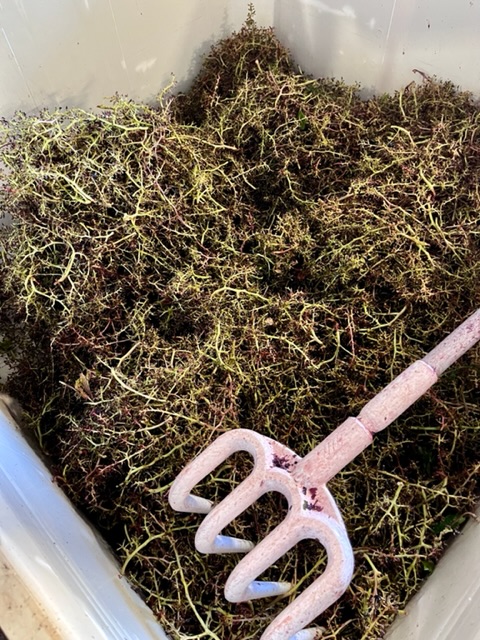
The stems accumulate after the fruit has been removed for winemaking
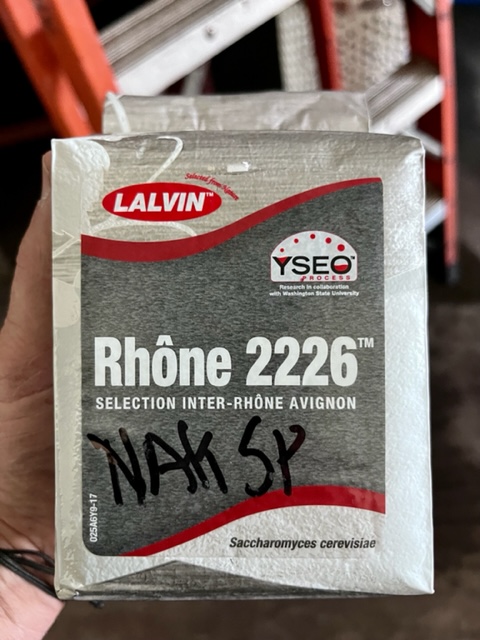
After the fruit is moved to a fermentation tank, and lab reports have been studied, we re-confirm our goals for the wine. Carefully selected yeast is added to get the fermentation rolling. In this case, a yeast from the Rhone region is specially selected for Syrah and Grenache which are Rhone varieties.
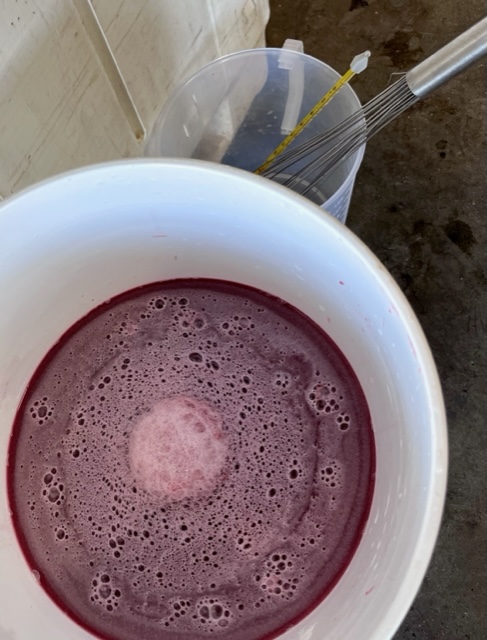
The yeast is very carefully rehydrated, and then slowly small amounts of cool raw grape juice is added and the yeast cells adjust to the temperature and awaken.
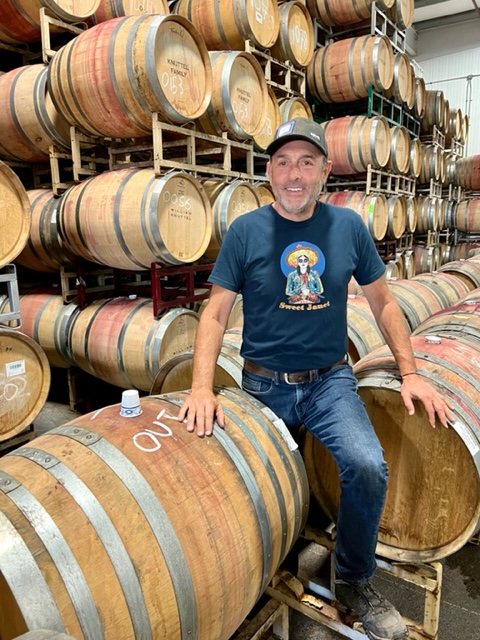
Lots of oak barrels must be prepped because soon enough, all these tanks of wine will complete fermentation and, one by one, those wines must be quickly moved into barrels where the long aging cycle begins. (footnote: T-shirt was a gift from Chewy, my Desert Caballero ace cowboy buddy)
Pizza party at the Winery, at about the halfway point, 6 weeks in and about 6 weeks to go…
Exhausted but happy, a moment of pause for some local Mary’s Pizza with the awesome winery team. Pacifico (yellow cans) was the beer of choice for all on this day – except of course for one of the guys who always wisely choses a Coors Light…see the empty seat…yup…I made the right choice!
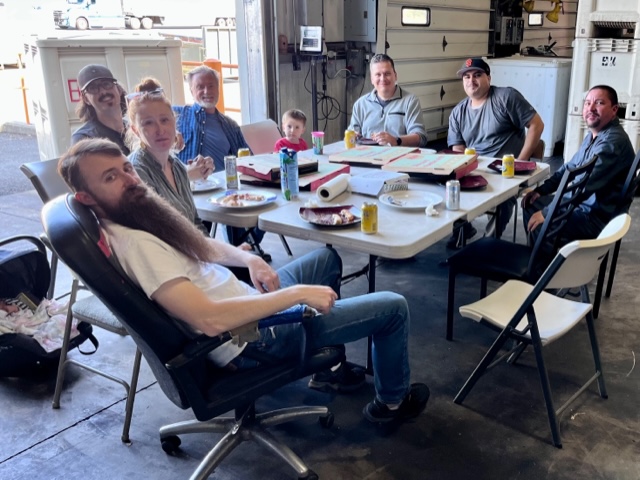
The team at Arcana Custom Crush Winery on 8th street east in Sonoma, the management and cellar crew, from left to right: Sebastian, Kate, Mat, Bill, Landon (Maverick), Miguel, Jose, Jesus
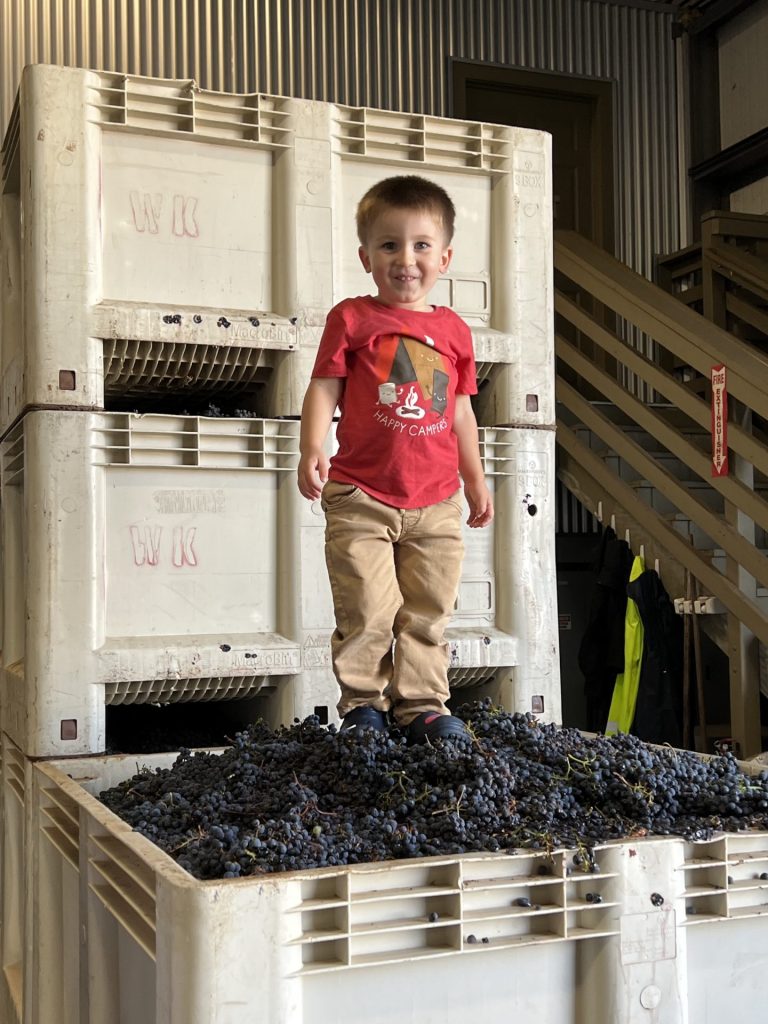
Our winery mascot, Kate’s son Landon, welcomes another load of fruit by crushing it with his own feet. I like to call him “Maverick” because he looks like Tom Cruise from Top Gun, and moves around the winery at the same speed. If you’re a mom and it’s harvest time, the kids go to the “office” too and become part of the action.
Mid-October, yet another harvest, and this time breakfast is included!
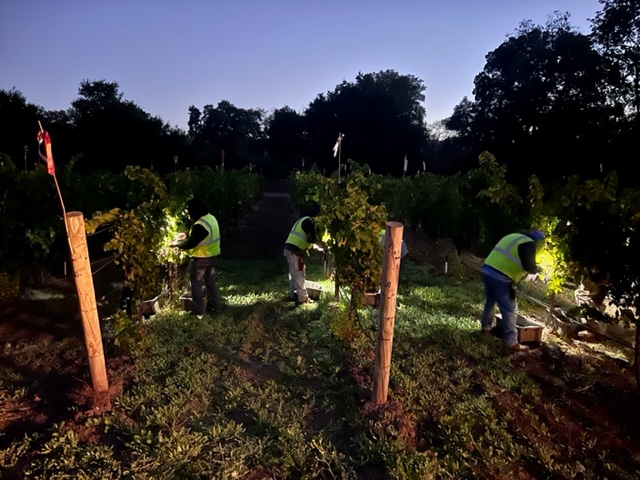
Starting in on a some short rows as the sun rises
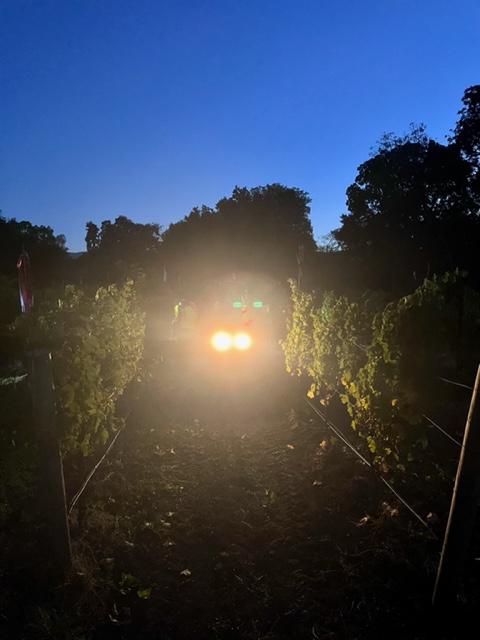
The tractor leads the way pulling bins quickly filling with fruit
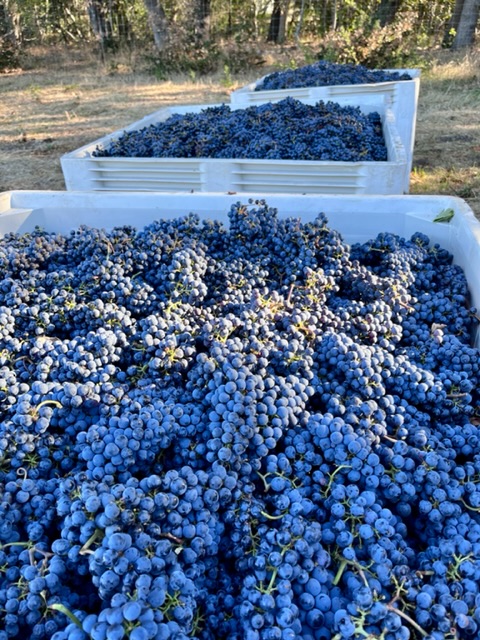
This is what really pristine Sonoma Valley cabernet sauvignon looks like
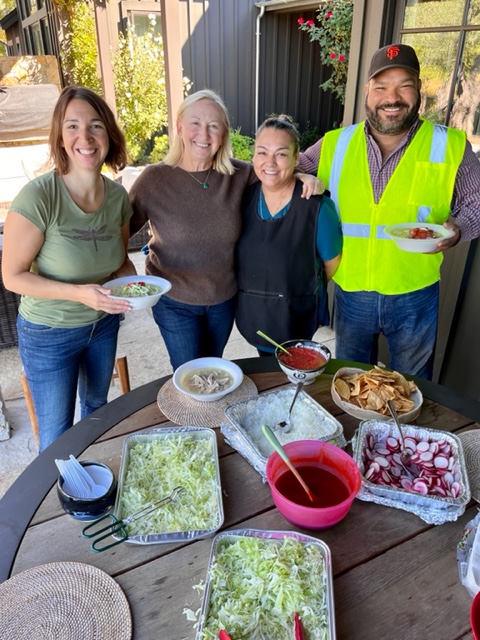
After this harvest, our wonderful client offers everyone a delicious meal. Last year was tacos and tostadas, this year was an amazing Pozole soup made of pork and hominy (the word “pozole” is thought to come from Nahuatl, the Uto-Aztecan language spoken in various forms during pre-Hispanic times).
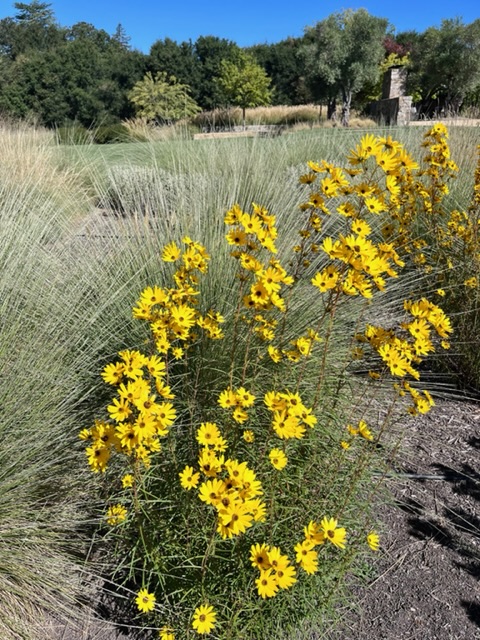
Vibrant “thin-leafed sunflower”, always blooming around Sonoma at harvest time
Jack London State Historic Park – and the Park Partners – there is always time in Sonoma for another gala non-profit fundraiser!
Jack London Park Partners emerged during a budgetary crisis in 2012 which shuttered many state parks. It was the first non-profit organization to take up management of a state park on behalf of the people of California and it has been successfully running Jack London State Historic Park ever since. If you haven’t been, please do schedule a visit. It’s very scenic and historic too.
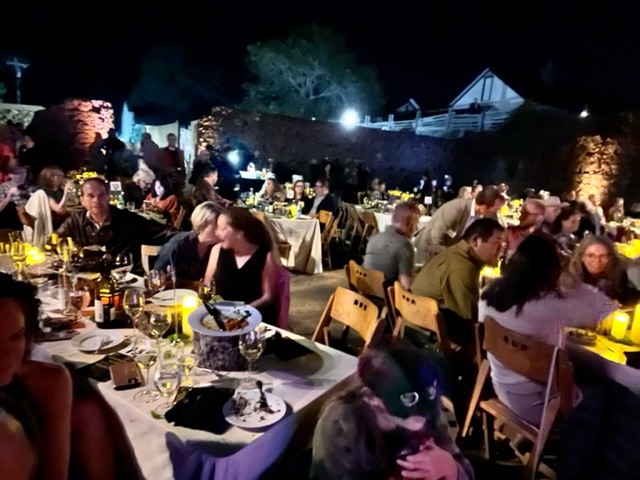
Park Partners hosted a sold-out entertaining outdoor gala event on Sept 24th.

The staged event theme, as seen here, was “Once upon a time in a not so distant forest lived an ancient redwood tree who silently presided over her forested sanctuary.” Adults and kids, dressed up as tree and forest creatures, was totally entertaining. A real hoot!
Final Harvest of 2022 – the last fruit to ripen and the final harvest of the year – our very own Sonocaia estate Sagrantino from here at the Hydeout Ranch
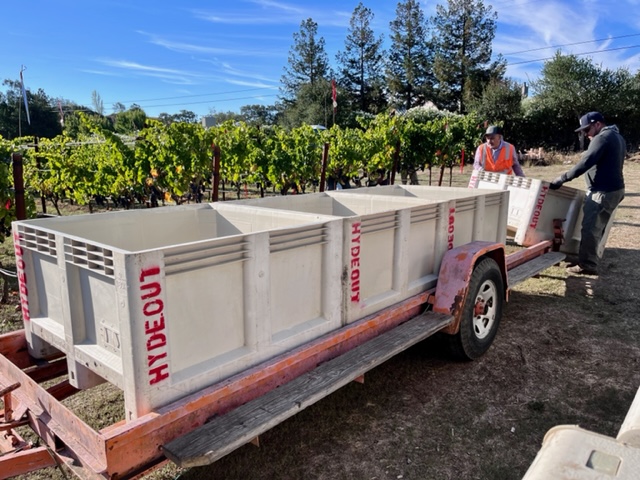
These Hydeout half-ton bins are cleaned, loaded on the skid trailer, and waiting to be filled.

It was a very cool damp night so we waited until the sun was up and dew was off the fruit before picking, but still it was just 40F outside.

The first of several bins begins to fill, and the fruit will be on its way to the winery in moments.
Vintage 2022, you started off so perfectly, with a terrific mid-winter atmospheric river and a lovely mild spring and summer, but then you turned on us and cooked us to a crisp for five days at +110F, and then you rained more than inch on us, and then it turned cold. Just another hah hah season in wine country.
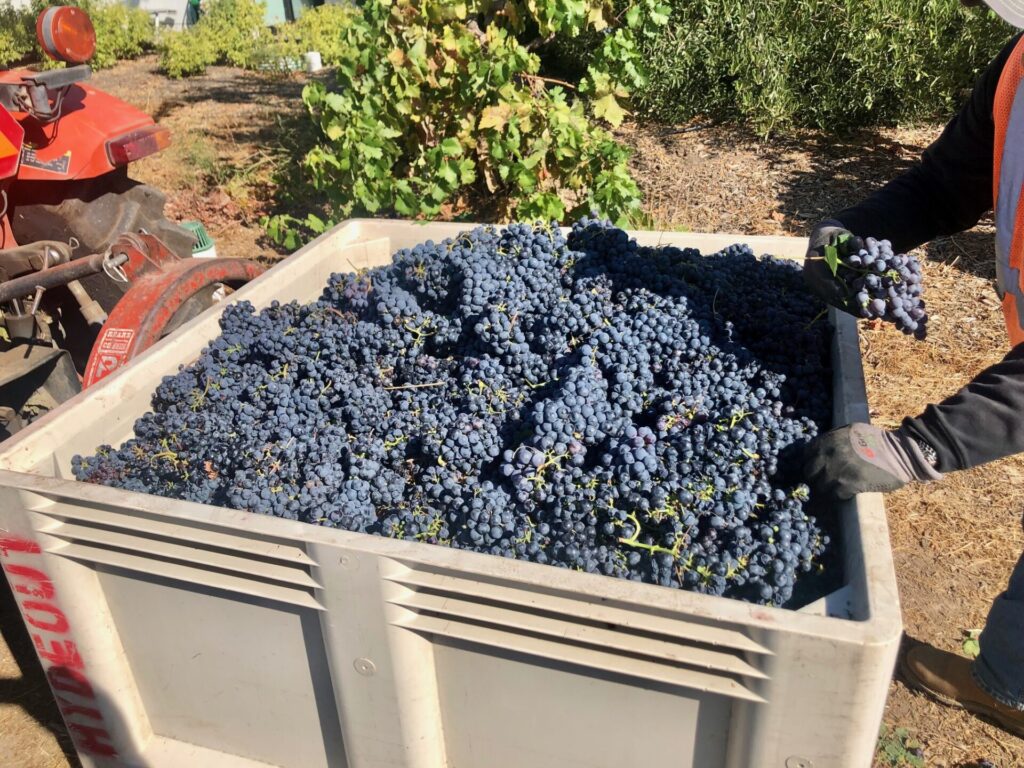
The final lug of 2022 grapes, our inky tight-bunch Sagrantino…ahhh! We’ll start pruning all the vines in February and the process repeats yet again.
If you are still reading?…
Late into October 2022, and the first of our client’s harvested grapes (from late August harvests) have completed fermentation. We’ve pressed the wines off, settled in tank, and now it’s time to barrel them down and put these wines to bed for the winter:
A final acknowledgement – Nunez Vineyard Management:
I first met Mike Nunez and his family, of Nunez Vineyard Management, going all the way back to when we opened La Honda Winery in Redwood City more than 20 years ago. A client of Mike’s who owned a vineyard in Sonoma sent his fruit down to us to process. That year, the fruit was harvested late and we ended up making a beautiful port wine. Mike drove the fruit down himself. I met him at our loading dock. We’ve been friends and colleagues ever since.
The Nunez family has deep roots in both Sonoma and Napa. We partner with them on many client projects, and our combined knowledge and experience creates a great outcome for everyone.
And, everyone involved in the growing of grapes and making of wine is publicly acknowledged at this Nunez Vineyard Management harvest party. A class act!
Next year, I think it will be fun to post a blog looking back over my 23 vintages. For now, here is a sneak peek looking back to the year 2000, and the founding of La Honda Winery, in Redwood City:
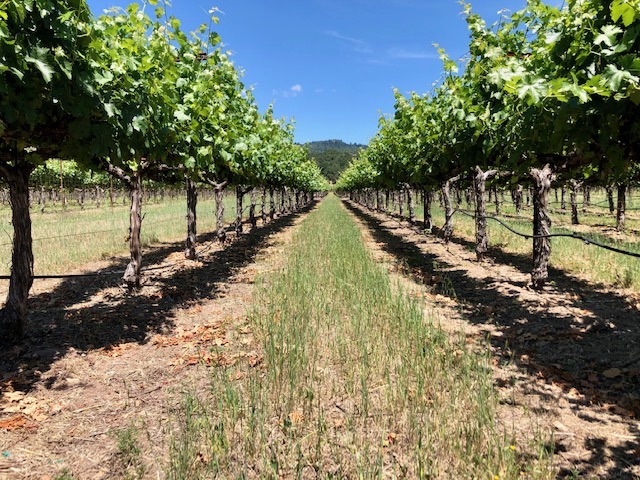
Jun 3, 2020 | Sonoma, Sonoma Farming, Vineyard, Wine
Hydeout Sonoma was selected by one of the arms of the historic Sebastiani wine family to return two iconic vineyards to their former glory. But it almost takes a secret Sonoma decoder ring to explain the vaunted family history, players, vineyards, and wines. More on that later. Let’s start with the work in process…
“Los Liones” vineyard block: Hydeout Sonoma was tasked with the complete renovation of this famous vineyard. Here is an abbreviated one-year pictorial essay following the reborn “Los Liones” vineyard, from raw land to completed vineyard:
“Stone Fruit Square” block: We then cast our eyes on the equally iconic “Stone Fruit Square” vineyard just east of downtown Sonoma at the intersection of Lovall Valley Road and Gehricke Road. This 25-year old quadrilateral-trained Cabernet vineyard was once a part of the renowned ‘Cherryblock’ vineyard. Now, a piece of the famed ‘block’ has been segregated away and re-named “Stone Fruit Square” (this is August’s terrific play on words!). This fruit is also destined for the “Gehricke” ‘Upper Eastside’ label.
Now, the rest of the story…
Don and Nancy Sebastiani are the 3rd generation owners of the “Los Liones” vineyard. Their children, Donny, August, and Mia all have their hands in interesting wine country ventures. Fruit from the “Los Liones” vineyard once went into a small production red wine called Subterra. Mia’s husband, Kendrick Coakley, along with his local friends, made a beautiful red wine from the “Los Liones” block. When 3Badge CFO Keith Casale handed me a bottle of Subterra, I opened it with some noteworthy Silicon Valley execs who have impeccable wine cred. They joined me in becoming immediate customers of Subterra.
But old age took down the original 1960’s era “Los Liones” vineyard and a replanting plan was set in motion last year (as you read about above). In parallel, we shifted the farming of the “Stone Fruit Square” vineyard from commercial mechanized farming to hand-cultivated farming. We intend to deliver deeper darker fruit as a result. August is the founder of 3Badge Beverage Corp. which is located in the former ‘firehouse’ at the corner of Broadway and Patten and the company “3Badge” is named in honor of family members who once held positions in the police and fire departments. Fruit from the “Los Liones” and “Stone Fruit Square” vineyard blocks will be combined under the Gehricke label as a ‘vineyard designate’ called “Upper East Side” (as both vineyards are located in the swanky upper eastside neighborhood of Sonoma town).
Hydeout Sonoma will continue to develop and farm these iconic vineyard blocks. And we’ll do our best to bring forth fruit that will assure that the “Gehricke” ‘Upper East Side’ vineyard designates continue their iconic reputation.
Additional vineyard notes (for those who just can’t get enough technical info):
“Los Liones” vineyard:
- Plant type – Ubervine from Novavine
- Variety – Cabernet Sauvignon
- Clone: VCR 198.1 (proprietary selection from Vivai Cooperativo Raucedo via Foundation Plant Material Services at UC Davis)
- Rootstock: 110R (berlandieri x rupestris, medium vigor, loves hillside gravelly soils)
- Vine architecture: bi-lateral cordon (moving toward cane-and-spur in year +/- 5)
- Farming: 100% organic, irrigated during youth, moving toward deficit irrigation
“Stone Fruit Square” vineyard:
- Planting – old school 1960’s plant canopy and spacing
- Variety – Cabernet Sauvignon
- Clones: Various
- Rootstock: St George (‘terra rosa’ volcanic soil)
- Vine architecture: quadrilateral cordon
- Farming: 100% organic, deficit irrigated and/or dry farmed depending on the year
@gehrickewines
#gehricke
#gehrickewines
A final thought: We are in a time of terrible upset in our great country. It seems as if everything is politicized and polarized. We at Hydeout Sonoma takes very seriously the issues we are all confronting. But our blog post is not the forum for otherwise welcome debate. Still, we hope for health, peace, and liberty for all.
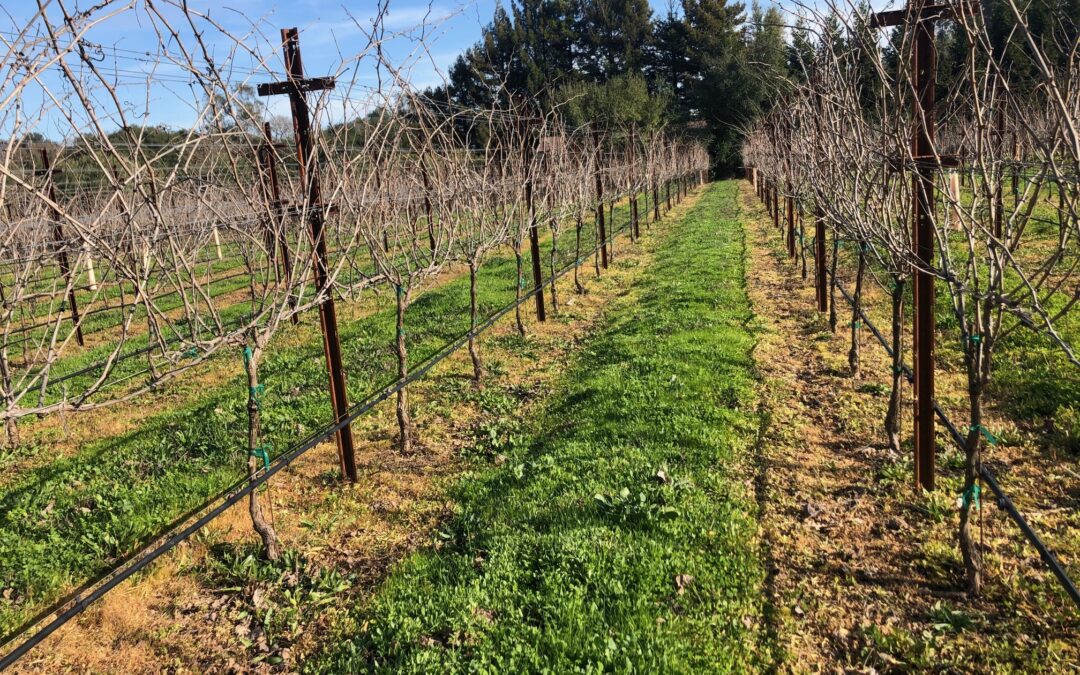
Feb 21, 2020 | Sonoma, Vineyard, Wine
Organic grape and wine farming: Thanks to the support from all of our Hydeout Sonoma vineyard clients, we are a 100% organic farming operation. As this debate continues, I invite you to take an in-depth look at the differences between conventional and organic. Let’s start with some revealing imagery:
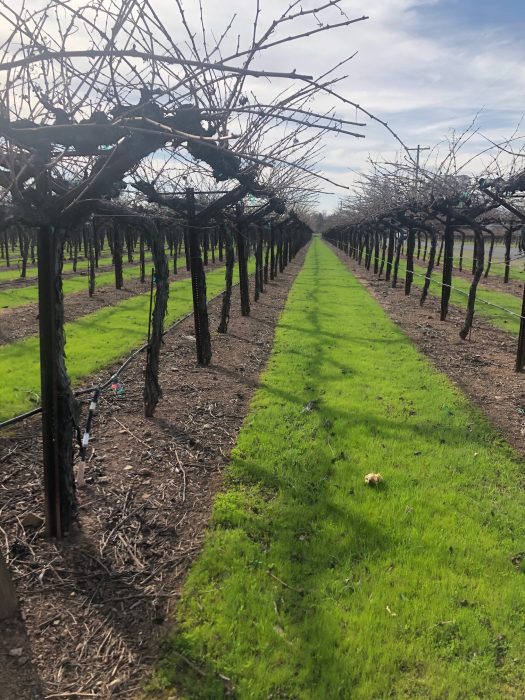
This is what a vineyard floor looks like when it’s been sprayed with Roundup. Note the complete absence of problematic weeds, nothing to compete with the vine’s roots, squeaky clean, nothing will grow on this bare dirt except the grapevines. This is a good thing if you want to assure that your grapevines aren’t competing for nutrients and water.
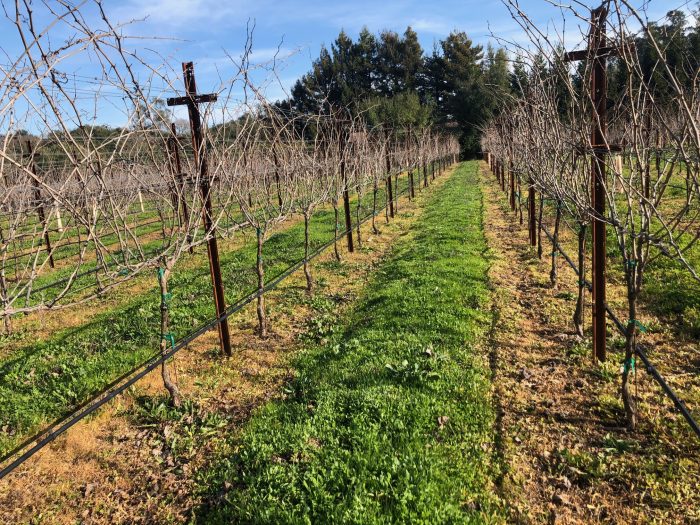
Take a look at the organic farming approach – in this case using the Weed Slayer. Note the absence of most problematic weeds growing under the vine rows. You will also notice the soil under the vine rows roughly almost the same result as Roundup.
Next, let’s debate the topic: with Roundup, one spray pass in the vineyard and every weed is gone for the season. In terms of cost effectiveness and the near-absolute eradication of weeds competing with the vines for water and nutrients, Roundup is the clear winner. However, Roundup seemingly kills most soil born microbes and beneficial insects. With an organic approach like Weed Slayer, the material for each application is about 2X-3X more expensive, and multiple passes are often needed, because the product doesn’t ‘knock down’ the weeds quite as well, and so in total it costs a little to a lot more for the same level of effectiveness as Roundup. But, it is organic.
If you were the farmer, what option would you choose? With Roundup, there is an alleged risk to health. The health risk is presumably much lower using the organic product. But, the organic option will add substantially to the labor and spray costs of your crop. How do you choose to compete?
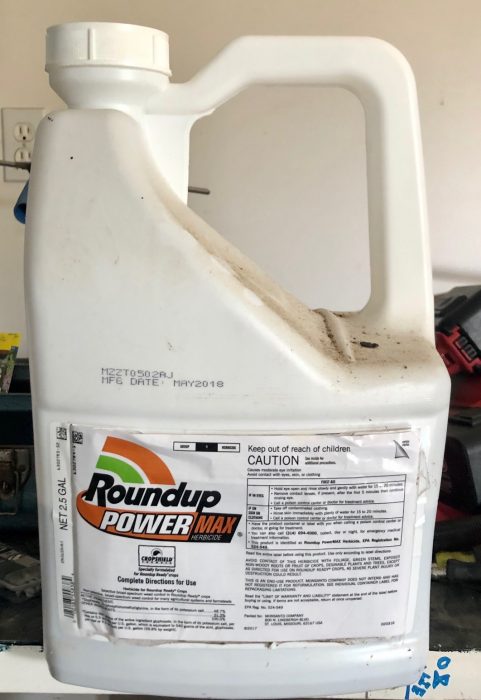
Roundup is a Glyphosate and comes with a standard “Caution” warning. It is thought to be particularly dangerous to honey bees.
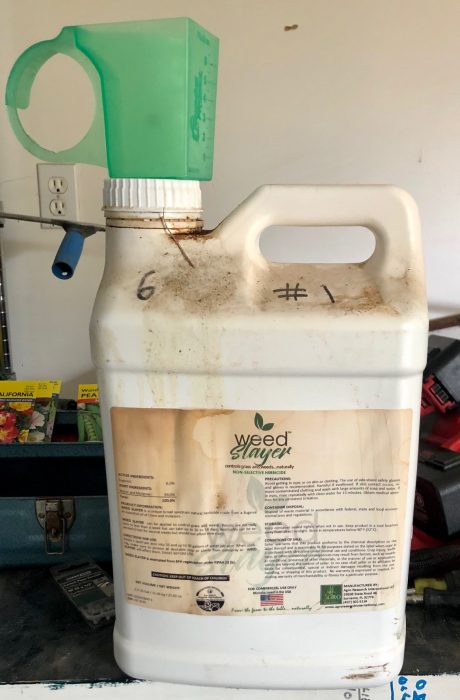
Weed Slayer consists of two separate products (Parts A & B) that you mix together to make one exceedingly effective weed killer. Part A is the Weed Slayer, a broad spectrum herbicide crafted from Eugenol (an essential oil from cloves) and molasses. Part B is Agro Gold, a biological adjuvant containing Streptomyces and Bacillus microbes. The Eugenol and molasses in Part A will make its way down to and kill the roots and/or root ball of the undesired plant. The soil enhancing bacteria in Part B clears the way for and drives the Eugenol down into the roots. This action allows Weed Slayer to kill the whole plant quickly, including the root system, making it more effective than “burndown herbicides” for ongoing weed control.
Winter soup, chickens, eggs, and raised beds:
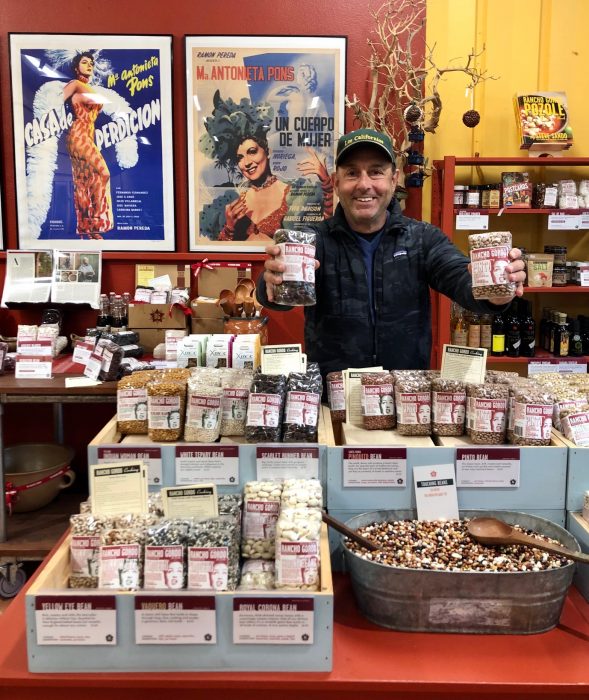
One of our favorite weekend stops for supplies to make a delicious pot of soup on cold winter nights; nothing beats Napa’s “Ranch Gordo” beans, a super high quality company with typical and unusual bean varieties. And lots of other products and great recipes. Really lovely people too! See this link: Rancho Gordo specialty foods and heirloom beans

A happy Valentine…sun-glassed Cynthia Wornick displays eggs from our expert chicken neighbors next door, Lori and Steve Bush of Gremlin Farms. And just this week our own Dysfunctional Family chickens began laying too.

Hydeout Sonoma’s winter garden is pushing onions, kale, potatoes, carrots, and beans; all will be ready to harvest in early spring. The Dysfunctional Family chickens pretty much mowed down the broccoli (4th raised bed from the left), so their ‘free range’ was slightly curtailed while the garden is in action! We’ll plant the summer crops soon – tomatoes, basil, lettuce, and so on. (I started the willow trees in the background from cuttings and they’ve grown to 20 feet in 4 short years).
Violins of Hope
The Nazis used music and especially violins to humiliate and degrade Jews in ghettos and in concentration camps. They confiscated many thousands of instruments from Jews all over Europe. Camp victims were forced to ‘play for their supper’ as the Nazi’s gorged on their meals while camp victims were forced to play music while slowly starving.
After the liberation many of these violins, some recovered with human ashes inside, were sent to Israel where they were lovingly re-built. And now they are on a new life-affirming journey where these instruments are once again being heard by audiences. The Violins of Hope concerts are the ultimate survivor’s reply to the Nazi’s plan to annihilate a people and their culture, and to destroy human lives and freedom.
My parents, Anita and Ronald C Wornick, underwrote a Violins of Hope event in San Francisco last week. I am of course very proud of my parent’s continued resilience on this topic as they lost many family members during the war, in camps, in the Ponar forest (near Vilna, home to many of my ancestors), and they continue to this day to raise awareness and celebrate our family heritage…
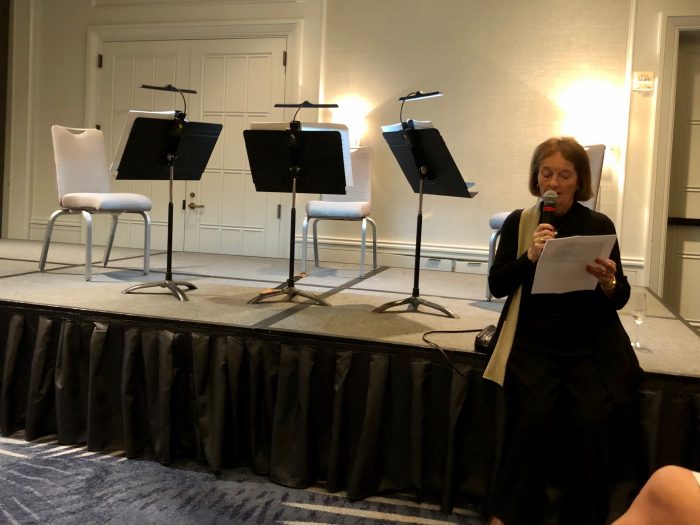
This is my adorable mom Anita who at 83 years old is as vibrant and fun as ever. My dad, Ron, at 87, was sitting in the audience with our children and brothers, leaving it to our Mom to make the introductions.
Please watch this brief video of 3 “Violins of Hope.” These 3 talented SF symphony musicians are playing 3 of the actual recovered and rebuilt instruments (2 violins and 1 viola): Brief “Violins of Hope” video from San Francisco
Want to know more about who rebuilt these instruments? Click here: Amnon Weinstein – repairer of violins
Artisan furniture master woodworker Stine Poole
Stine Poole, is a close family friend who operates a noted wood and furniture studio in San Diego. Stine sources wood from all over the world including from his noteworthy High Valley Ranch in Montana Stine’s studio can be found here: Stine Poole – Furniture by Design. If you have reason to commission a special piece of furniture to fit an exact need, please contact Stine. He would be delighted to hear from you. Following here are few images of some current work in progress. Click on the website to see more images. Stine Poole – Furniture by Design
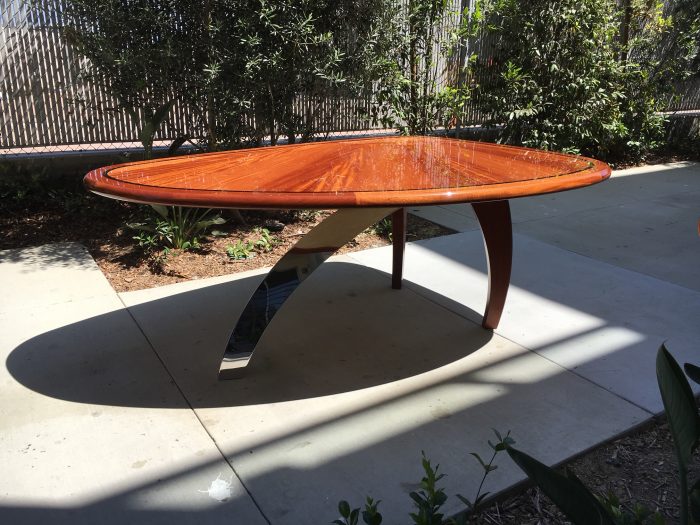
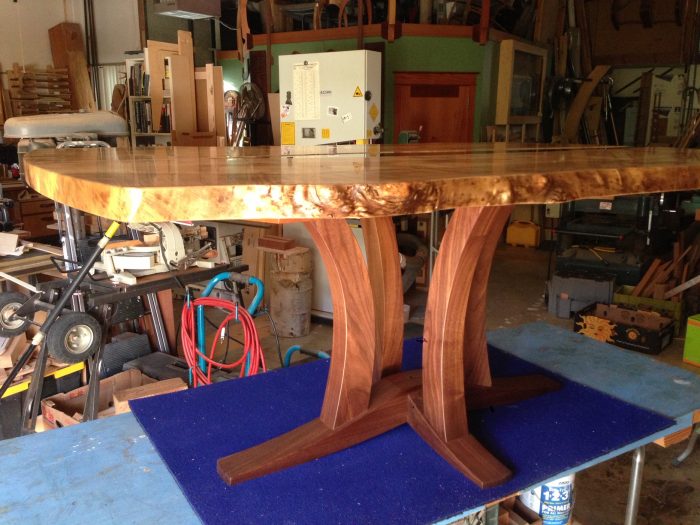
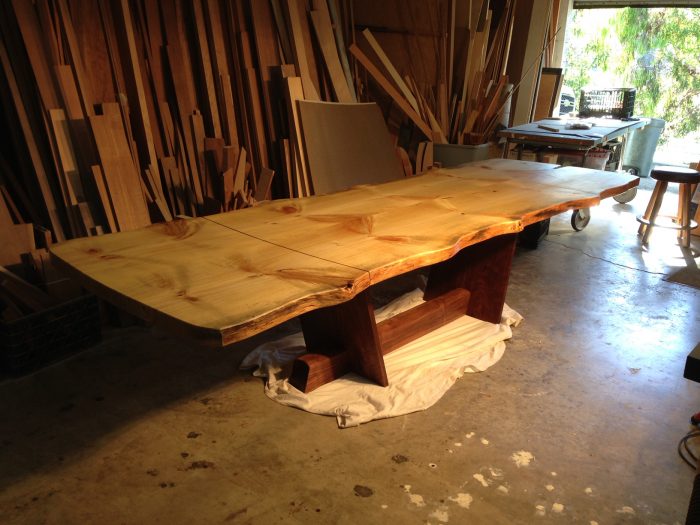
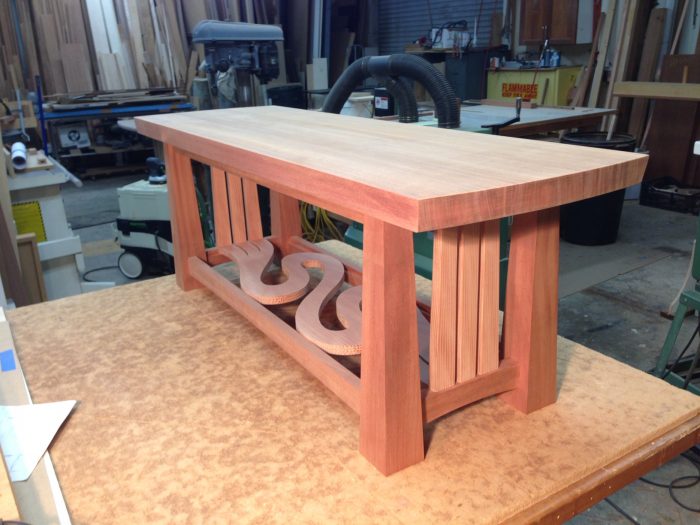
Full Moon Hike to Bald Mountain
Our constantly evolving group of local hikers routinely depart just before sunset to climb Bald Mountain inside the Sugarloaf Ridge State Park in Sonoma, arriving at the top just as the full moon rises over St Helena and the Napa Valley. We climb approximately 1,500 feet in 2.5 miles, pause to watch the full moon rise, share some great snacks, pass around Tequilla shots, and head down hill under the light of that full moon.
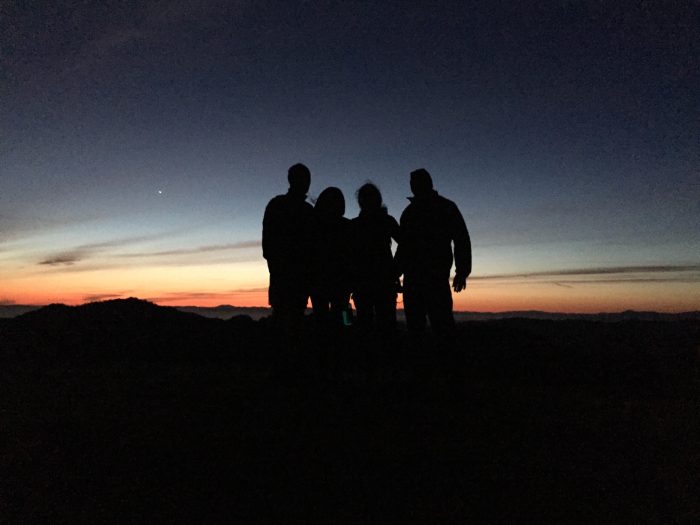
We’ve reached the 2,729 foot summit just as the sun sets and the full moon is about to rise. Looking south from the summit in Sonoma is the Napa Valley, Vallejo, and the Bay.
The Sonoma Valley Museum of Art “Summer Solstice” Party
After six years on the board of the Sonoma Valley Museum of Art, I will be terming out. But I’ll still be around for more museum fun…in this case the museum hosts an ongoing series of events called “Great Places, Great Spaces.” Along with our neighbors Steve and Lori Bush of Gremlin Farms, we will be hosting a progressive event, drinks and apps at Hydeout Sonoma and dinner at Gremlin Farms. Please join us. Click on this link for tickets to our event: Great Places Great Spaces at Hydeout Sonoma and Gremlin Farms
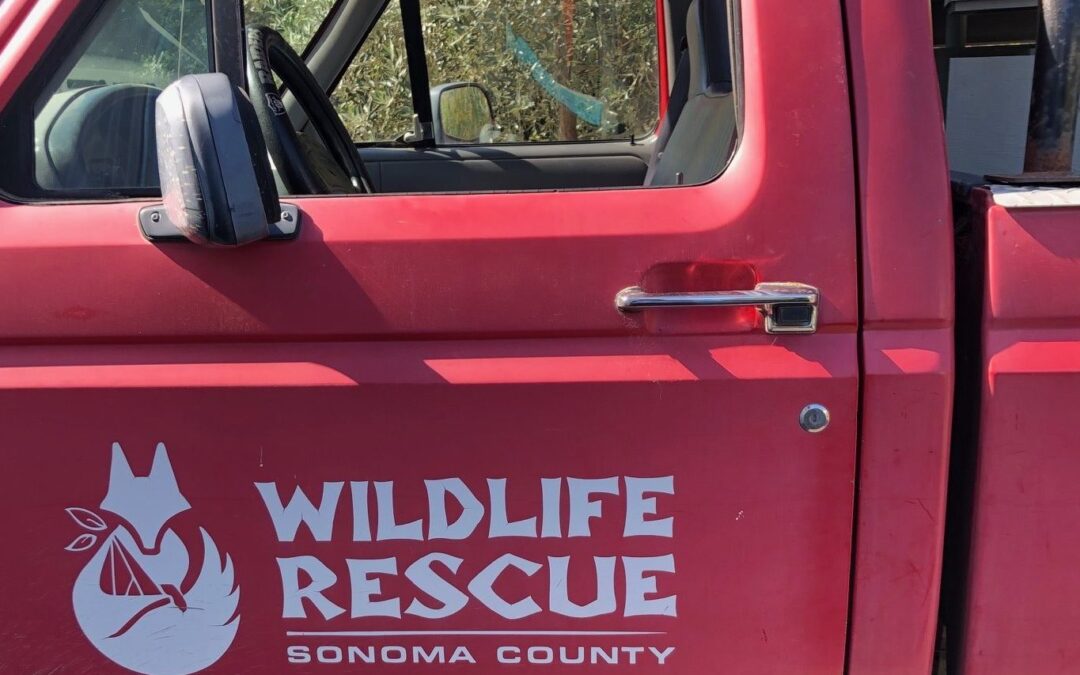
Sep 28, 2019 | Sonoma, Vineyard, Wine
Sonoma Barn Owls and social tidbits…we’ve lost many grapevines, three years in a row, to damaging gophers. The gopher population is out of whack. Hard to say why? Maybe not enough snakes? We don’t want to use poison or traps, so what’s the better option? Owls! (not interested in Owls? Scroll down for Sonoma social tidbits)
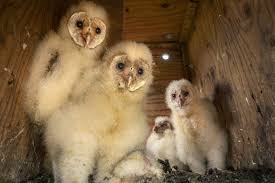
A single owl can eat 155 gophers per year, equal to almost 55 pounds of gophers! Imagine what this family of barn owls will do?
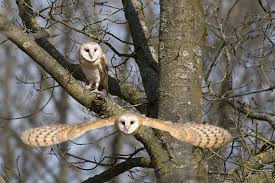
They are nocturnal, hunting mainly at night; this image captured a couple of stealthy killers in broad daylight.
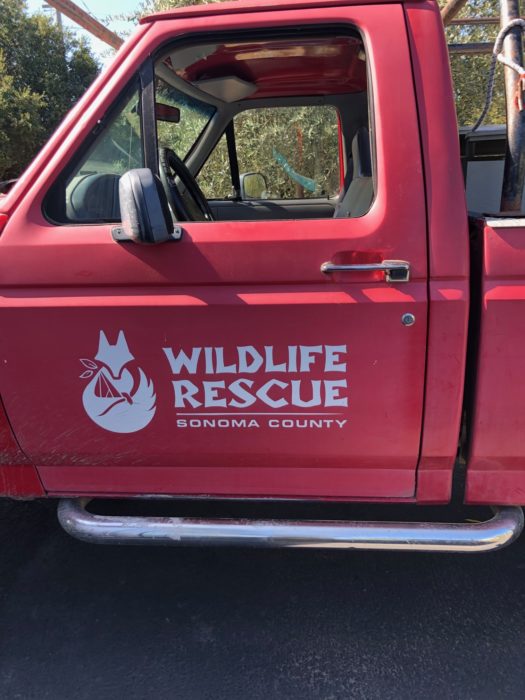
“Wildlife Rescue” from Sonoma County offers an owl box program. We hired them to build and install 3 new owl boxes on the ranch. They have a barn owl program tailored for almost any location – Click: Wildlife Rescue, Sonoma County, Barn Owl Program
Owl box 1 was installed overlooking the house and yard:
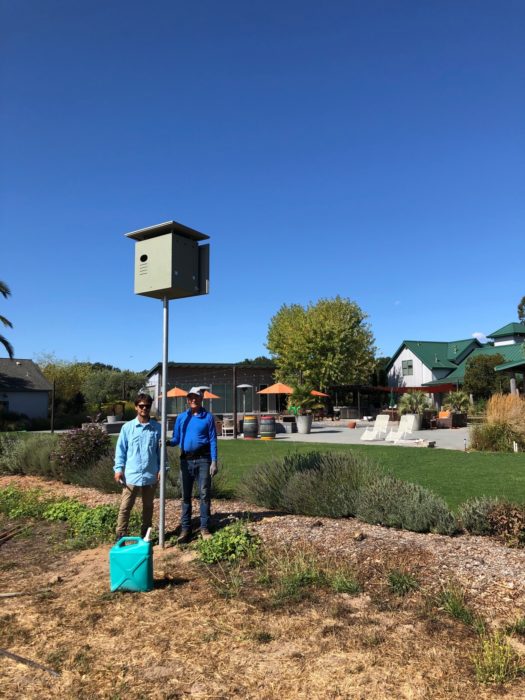
Owl box 2 was installed overlooking the vineyard:
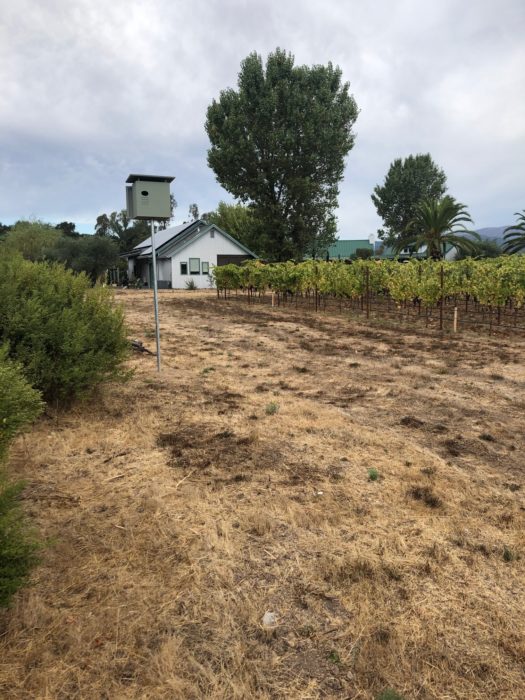
Owl box 3 was installed overlooking the hay field:
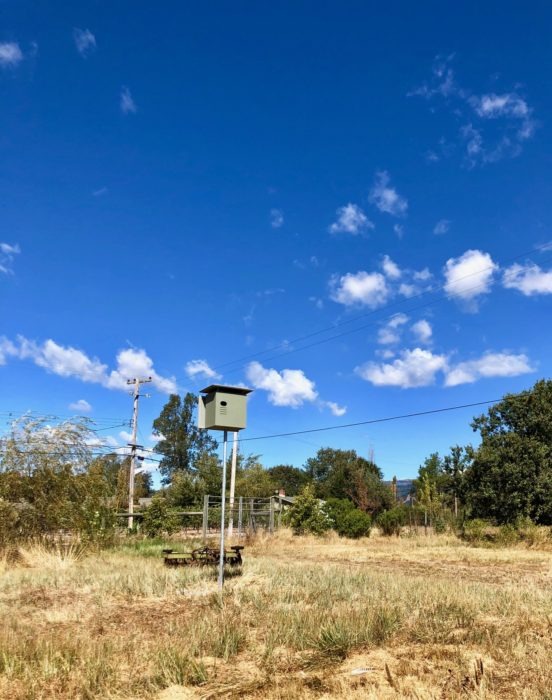
The official work shirt of Sonoma County BOMP – ‘Barn Owl Maintenance Program’ (shown here with famed owl box installer Mike McGuire).
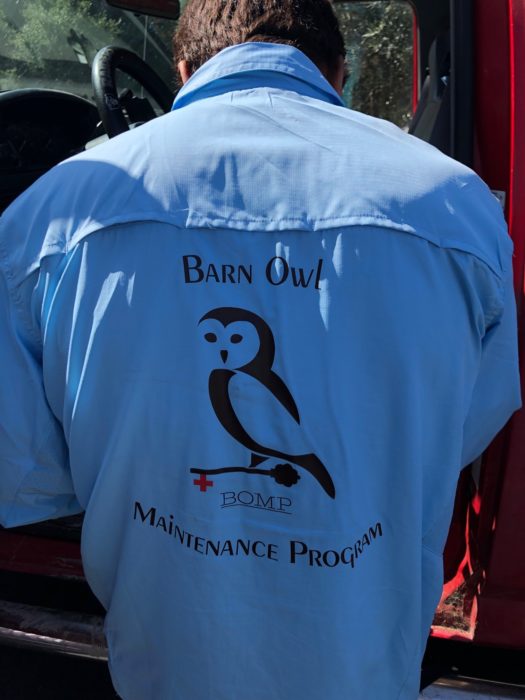
Mike is establishing the GPS location of each installed box:
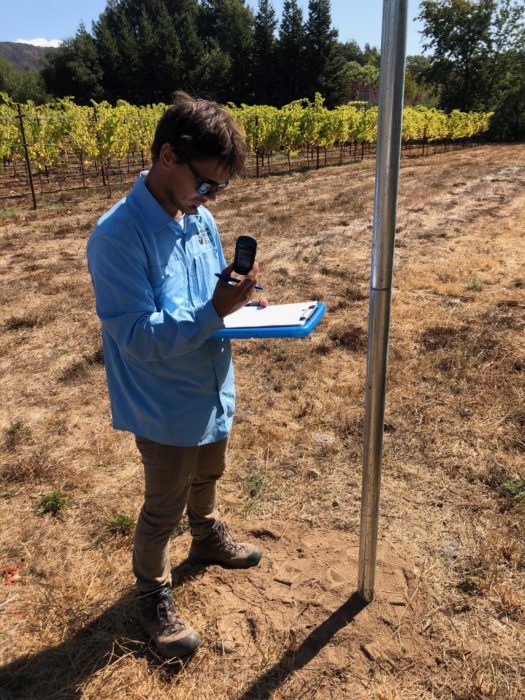
And the resulting GPS records look like this. This data gets entered into a database back at the office. And then tracked along with all the other boxes around the County. Hoping the boxes get some new Owl occupants soon:
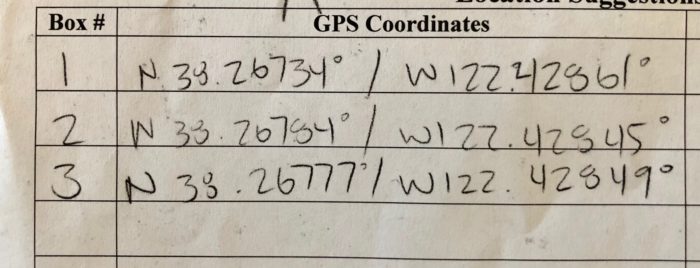
Recent socializing across the Sonoma Valley…
Vintage Festival – The Valley of the Moon “Vintage Festival” is running this weekend. Click on the video below to see a short clip from last night’s parade which is primarily a series of glow-in-the-dark floats from the Sonoma Valley schools. A great small town tradition…
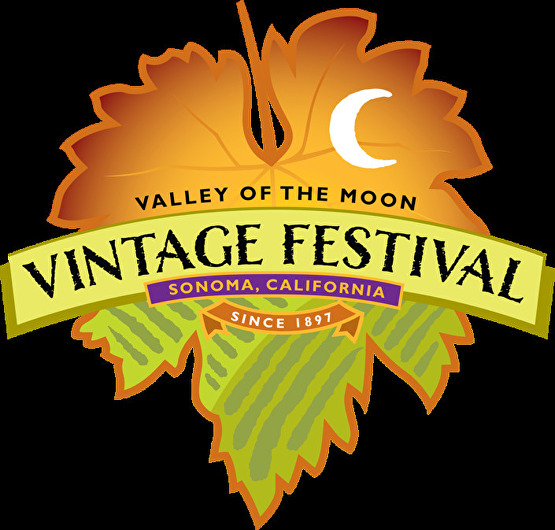
Video: Vintage Festival “Glow in the Dark” Parade
Harvest: Our first full crop of estate fruit was harvested on Monday. This fruit will be the basis of the ‘yet-to-be-named’ 100% Hydeout estate wine made of 87% Sagrantino, 6% Petite Sirah, 5% Cabernet, and 2% Primitivo. It follows on the heels of its sister wine, the Dysfunctional Family Winery “Red Blend”.
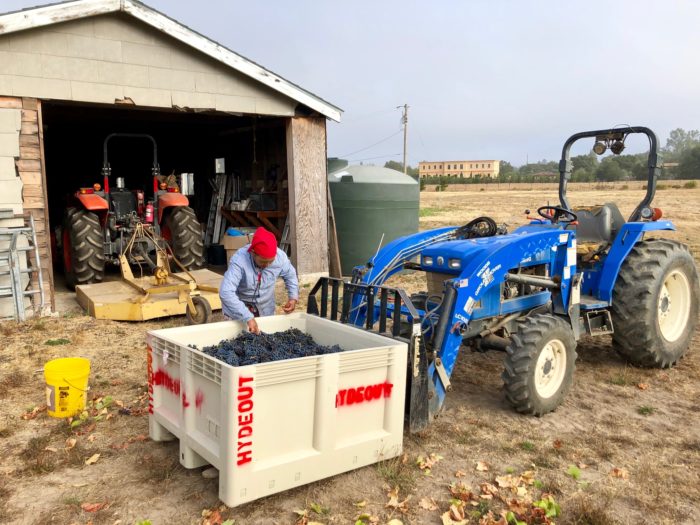
2 tons of the estate fruit blend getting ready for the flatbed truck:
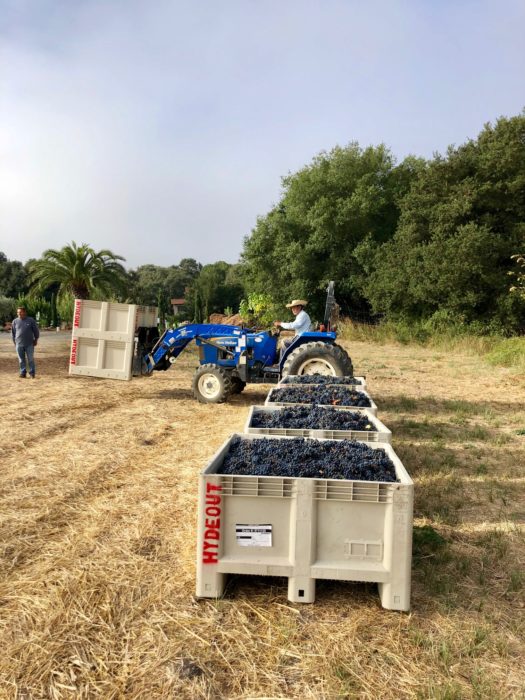
Movie night: Hydeout Sonoma hosted 125 people to an outdoor movie event benefiting the ‘Sonoma International Film Festival’. The film festival is scheduled for next March 25th-29th, 2020. It is my very favorite event of the year in Sonoma; seeing films all day, meeting actors and directors and film buffs, enjoying great wine and food, parties at night, etc. Get tickets here: Sonoma International Film Festival. And here’s a short clip of the film we screened on Friday night, Jonathan Demme’s “Stop Making Sense” by the Talking Heads:

Video: Talking Heads at Hydeout Sonoma
Sonoma Parks: We attended the annual event benefiting the Jack London State Park, and honoring several major Sonoma luminaries, including entertainment and an incredible meal served by honoree and Chef, Ari Weiswasser, of the Glen Ellen Star:
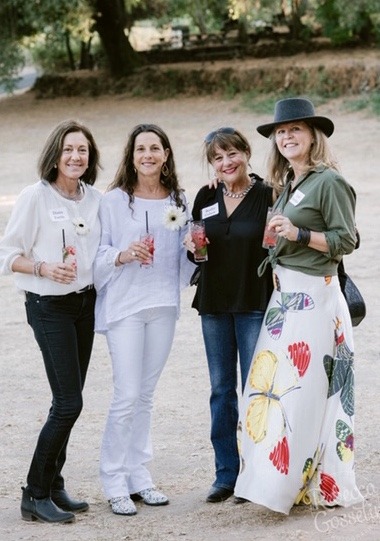
Diana Ferris, Cynthia Wornick, Basha Cohen, and Lynn Goodman (cocktails locked and loaded)
Video: Jack London State Park event
Closer to home: Cynthia Wornick is busy prepping ‘Early Girl’ tomatoes from the Hydeout gardens; her 13th batch of tomato sauce (much of which has been sent to the freezer where it will re-emerge during the winter as a delicious memory of the summer 2019)
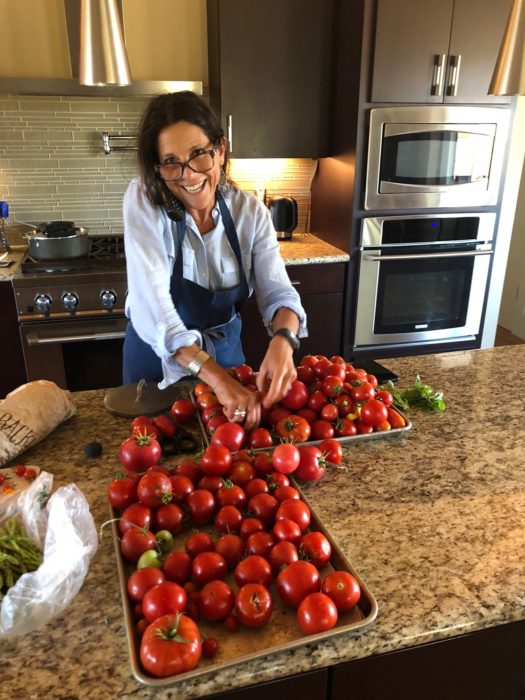
In the winery (part 1): Doing it the old fashion way, making sure a client’s precious fruit is carefully ‘macerated’ by the gentle action of human feet before the fermentation begins. Don’t laugh, this really is a great tried-and-true way to break up the grape skins (and release color and flavor) without breaking the grape seeds (which can release objectionable tannins into the wine). And yes, we washed my legs and feet thoroughly with citric acid. This approach works especially well for small quantities of fruit such as this half-ton bin of Sonoma Valley Syrah and Cabernet Franc (with a small proportion of very aromatic Muscat Canelli tossed in)..
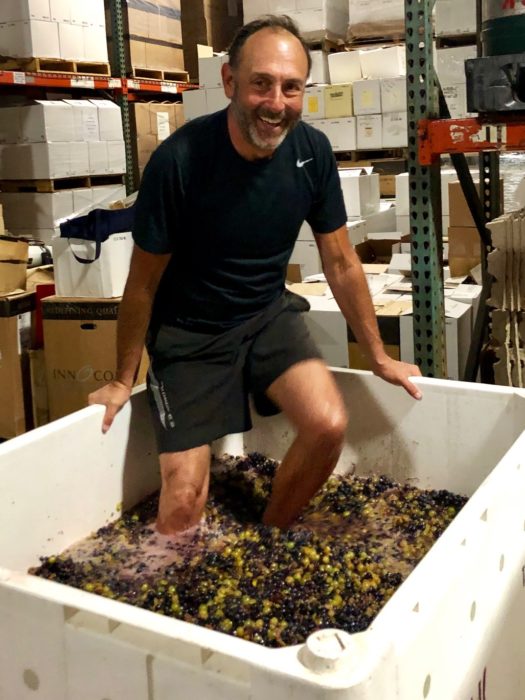
In the winery (Part 2): New York City clients with family and friends celebrating the 2019 harvest and tasting the 2018 from barrels…
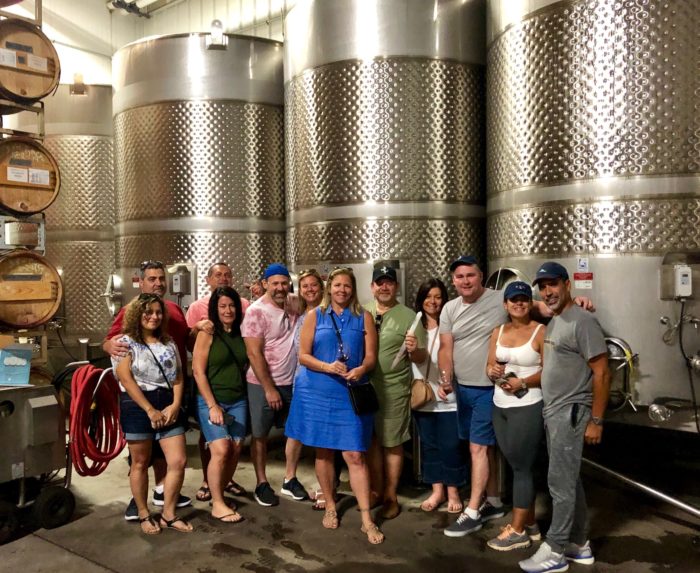
Bad Company concert at Silverado: It was a surprisingly energetic hard-rocking show. Here are a couple of videos…

Video: Bad Co.
Video: Shooting Star
Thanks for following these blog posts. Please let me hear from you…
Ken Wornick, http://www.hydeoutsonoma.com








